

Brazil is the giant of South America and the fifth-largest country in the world. We have been on a 10 weeks Grand Tour of this vast country, and have already been exploring Brazil for 5 weeks when we arrive in the Amazon, the largest State of Brazil (read Part I here) . Our Grand Tour has definitely stepped up a notch as Part II takes us to the fascinating city of Manaus, the capital of the Brazilian State of Amazon, and the heart of the incredible Amazon Rainforest.
From Manaus, we traveled deeper

Warning – this is a long post… but in my defense, it was a very long walk!
Our Camino Pilgrimage started in early September 2021 and we returned home in mid-October 2021. Altogether we spent 38 days walking every step of the official French Way almost 800Km/500miles route (although according to our Strava statistics we actually walked 845Km), carrying all our possessions in our backpacks.
Reflecting back now Brian and I often think “did we really do that?” or was it just some kind of dream we had? Often how you have imagined or expected something to be like, rarely turns out exactly as you had expected.
The Camino was like a different world, a place in which it was normal to walk many km/miles every day carrying all our belongings in our backpack, it was normal to experience daily pain, and in spite of the pain just carry on walking, it was normal that our main concern every morning was to check our feet…examining them carefully for blisters, hot spots and dealing with any feet issues before anything else. It was normal to be popping pain killers like they were delicious sweets. It was normal to talk to total strangers every day as if they were long-lost friends, it was normal to go to bed early, wake up early and step out into the marked path every morning to repeat another day of walking a very long distance.
There was a kind of beautiful simplicity in waking up every day with a purpose, a goal to reach the next destination. We knew every single item we were carrying and exactly where it was – inside which bag, inside which bigger bag inside, which pocket in our rucksacks. Never has the world felt so ordered. There were the daily reassuring routines, but also the excitement of what the road would bring. What would the path look like? Who we would be meeting along the way? Often our pace was the same as others and we would see the same faces who would be walking similar distances to us and we would all end up in the same town and even in the same Albergue for the night. We have made many wonderful friendships along the way.
Week One – The First 100 Km Are Usually The Hardest
St.Jean Pied de Port>Pyrenees(Borda)>Roscesvalles>Zubiri>Pamplona>Puente La Reina>Estella
Day one of the Camino Frances can be one of the hardest for pilgrims. Many choose to walk the 28.5km route from St. Jean Pied de Port all the way to Roncesvalles, crossing over the Pyrenees and climbing over 1,400m above sea level. We also chose this route, but we decided to split the first day and stop overnight at an Albergue (Hostel) called Borda, this proved to be the best decision we have made.
Before walking the Camino de Santiago neither of us had any idea of what it would feel like walking every day averaging 20 to 25 Km a day. We have always loved walking and would often do a 10 km hike near our home, but what we had not bargained for was the cumulative effect of walking many km/miles every day for over one month. We also fell into thinking after a 10 or 15km practice walk and still feeling good that we had done half a Camino day, so this is not going to be that tough. Mathematically that may be true, but you very quickly discover that the second half is way, way harder than the first… feet begin aching, soon hips and knees hurt, and also backpacks feel progressively heavier until all you can think about is getting to the hostel and collapsing in a heap. Whilst our cardiovascular health improved considerably, the long daily distances did not improve the health of our aging feet, knees, hips, and backs.
Every milestone is certainly a cause for celebration on a journey of 800km/500miles and completing 100 km felt absolutely great, but it also dawned on us the magnitude of this task. It took us about 5 days to complete the first 100Km of our route with many ups and downs not only from the region’s topography but also from the physical and emotional demands.
The first day stepping into the ancient route was probably one of the most memorable days of our Camino, being packed full of great experiences, starting with some of the most stunning scenery of the whole Camino, taking us over the amazing Pyrenees Mountain Range.
Little did we know then, that the relationships we formed on that very first day would become so important to us during our Camino journey. We found ourselves with lots in common with total strangers, sharing all the excitement of that first day on the Camino, sharing a meal, and exchanging life stories. Everyone was enjoying a kind of beginner’s high… we had all been planning and preparing for this moment for so long, years often, and in so many cases delayed because of covid, that to actually begin walking felt amazing. If it wasn’t so steep, I’m sure everyone would have been skipping up that road the collective mood was so high. We became a small community of people moving together, following the Camino signs. Sometimes walking together in groups, other times walking alone, but usually getting together in the evenings when we would be talking about our day of walking, our day of pain, our day of getting closer to our final destination. It was so easy to join another walker or a group of walkers along the way and just as easy to leave the group and walk alone if we so desired.
Some Pilgrims taking the route across the Pyrenees will often stop for a rest and or a bite to eat at the iconic Albergue Orison, some will also stay there overnight. We stopped there for lunch sharing a meal with Tom (from Ireland), Katrina and Matts (from Sweden), and Josh and Curt (from the US).

Sharing lunch at Albergue Orison’s terrace overlooking the Pyrenees. Anticlockwise from left: Brian, Kathrina, Matts, Curt, Josh, and Tom.

Sorry, not a great quality photo of our pilgrim’s evening meal at Albergue Borda, halfway up the Pyrenees.
 But our bed for the night was a couple of km uphill from Orison since we had booked a private room at Borda, a new Albergue just up the road. It also had great mountain views, it was spotlessly clean and very comfortable. The communal evening meal was a very social event with everyone introducing themselves and talking about their reasons for doing the Camino. These shared meals were some of our favorites. Here we met Stephen (from Dublin in Ireland), Cyril (from San Francisco, US), Michaela (from Prague, Czech Republic), and Carol (from Florida, US) they all became good friends with whom we have met up and socialized many times during our Camino journey.
But our bed for the night was a couple of km uphill from Orison since we had booked a private room at Borda, a new Albergue just up the road. It also had great mountain views, it was spotlessly clean and very comfortable. The communal evening meal was a very social event with everyone introducing themselves and talking about their reasons for doing the Camino. These shared meals were some of our favorites. Here we met Stephen (from Dublin in Ireland), Cyril (from San Francisco, US), Michaela (from Prague, Czech Republic), and Carol (from Florida, US) they all became good friends with whom we have met up and socialized many times during our Camino journey.
Our second day up in the Pyrenees started early, after a simple breakfast at the Borda Albergue where we had stayed the night before. A foggy, cool morning gave the landscapes an ethereal, mysterious feel. We followed the Camino signs, crossing over seamlessly from France into Spain up to the highest point. From there it was a few km descents into Roncesvalles and our bed for the night. From the Borda Albergue to Roncesvalles we walked about 19Km, with an elevation gain of 683m.

Crossing the border from France into Spain.

Curt and Josh got to the highest point ahead of us.

Roncesvalles Monastery and our bed for the second night on the Camino.
On the second night, we stayed at the amazing Roncesvalles Monastery, sleeping in a large dormitory with bunk beds (something neither of us had done since our 20’s). Staying at this ancient Monastery was an experience we both felt strongly about and we are very glad that we did it, in fact, it was actually better than we had expected with a comfortable bed and good facilities.

Albergue La Colegiata inside the old Monastery had small pods with 4 bunk beds and 4 lockers in each pod.
The following morning was rather surreal to wake up by a recording of Gregorian Chanting Monks at 6 am.
The walk from Roncesvalles to Zubiri was probably one of the hardest days for me, not because the terrain was particularly hard, but I guess it was a combination of factors, such as starting to walk without any breakfast, not having enough resting stops along the way and perhaps being a bit dehydrated from not drinking enough water throughout the day. We walked almost 24 km with an elevation gain of 407m and although we had booked accommodation to stay in Larrosoana (another 5 km from Zubiri) there was no way I would have made it there on foot, so Brian managed to find us a place in Zubiri instead, where I just collapsed into bed for a few hours.

Roncesvalles to Zubiri was probably one of the hardest days for me. There is a very steep and rocky descent at the end, just when you are getting really tired.
Zubiri to Pamplona was an easier day for us, we walked about 22 Km, with an elevation gain of 358m. This time we made sure to have a few extra resting stops, eating nourishing foods, and plenty to drink. As we entered Pamplona we were surprised by our friends from home, Mark and Marion. They had been touring by motorhome and were on their way to Portugal. It was great to see them and also have the opportunity to purge some of the items we no longer wanted to carry in our backpacks. Thankfully they were happy to help us out. Pamplona is one of the most beautiful cities on the French Way with a fascinating historic center. Since we had visited before, we did not do much exploring, settling for hanging out with our friends.

Meeting up with friends Mark and Marion from back home, at Pamplona.
Leaving Pamplona behind early the following day our next overnight stop was at Puente La Reina, with the main highlight of this day being the iconic Alto del Perdon a high point on this route with fabulous views from the top and the famous sculpture installation representing pilgrims doing the Camino de Santiago. The rocky terrain downwards towards Puente La Reina was hard on our knees, this was probably the hardest day for Brian with him feeling exhausted and dehydrated from the lack of shade and a very hot day. I started developing nasty blisters on my feet.

Iconic Alto Del Perdon
Puente La Reina was small but very pretty with the highlights being the lively Plaza de Mena, old atmospheric churches, and the old Bridge. We booked a private room just off the main Plaza and did some exploring in the evening before eating a delicious meal at a lovely restaurant with an open courtyard called La Drogueria.

Beautiful Puente La Reina.
Concluding the first week of our Camino journey and hitting the 124 km walked so far, we were glad to make it to Estella. A very pretty town, where we stayed at the gorgeous Hostel Agora, one of our favorite places with the most friendly reception of the whole Camino. The weather was not great with showers on and off, but we loved eating dinner at Restaurant Mundo, owned by a Dutch lady, and sharing a meal with Michaela from the Czech Republic (who we met on day one at Albergue Borda) and Derek, a 74-year-old Dutchman who was cycling the Camino. We were inspired and humbled by his spirit to take on this challenge with severe Parkinson’s Disease.
Week Two – Another 134 Km Walked and Taking A Rest Day In Logrono
Estella>Los Arcos>Logrono>Navarrete>Najera>Santo Domingo de La Calzada>Belorado
Between Estella and Los Arcos, we stumbled upon the Fuente del Vino, free wine was flowing here and although the wine was not top quality it was certainly a lovely surprise to find such generosity along the path, thank you Bodegas Irache. We walked some of the ways between Stella and Los Arcos with Michaela getting to know her a bit better, she spoke perfect English and she was doing the Camino to reflect on her life. She would have to skip a few parts of the route since she had less than 4 weeks’ holiday to do it.

Free wine at Fuente del Vino. Not sure I wanted a drink after this guy was drinking straight from the tap.
The walk was along vineyards and farmlands, and we got to Los Arcos early afternoon. The main square was lively with other pilgrims and so we joined them for drinks, there was a very friendly Brazilian couple called Claudia and Marcelo. Later on in the evening we also really enjoyed sharing a meal with fellow pilgrims at our Albergue, called Hostel Abuela, and being joined by the lovely Cyril (From San Francisco, who we also met on day one) as well as other pilgrims, including a French couple in their early seventies who had already walked over 600 Km across France from Le Puy.
From Los Arcos to Logrono we walked almost 30km, making it the longest day of our whole Camino. We learned that 30km days were not a good idea for us, the long day left us feeling exhausted and my blisters were causing me a lot of pain. In spite of the pain, there was some beautiful countryside scenery to keep us distracted, with quaint little towns and vineyards along the way. We particularly loved stopping for lunch at Viana, overlooking the stunning Cathedral, and chatting to Scottish brothers Ronald and Thomas. Ronald now lives in California, so the two brothers decided to do the Camino as a way of doing something together. We were impressed with the long distances they were managing to accomplish every day
But for us long distances meant very sore limbs and feet, so we decided to have a rest day in Logrono, eat tapas, and get some chores done. On the first night in Logrono, we met up with Stephen and Ken from Ireland, Michaela from the Czech Republic, and also Robert from California, the US who was completing his 10th Camino. It was interesting to hear his reasons for returning over and over to walk the Camino.

Evening tapas at Logrono. Brian, Stephen, Robert, Ken, Michaela and me.
There was more socializing on the second night in Logrono, since we accidentally bump into Josh, Curt (whom we have met on day one at Orison), and Josh’s Spanish friend (I can’t remember his name) and therefore all going for more tapas and drinks. They had stayed an extra night in Pamplona and hence we all ended up in Logrono together.
We did not find the resting day in Logrono very successful, since it frustrated us not to be making any walking progress, so we decided that we would not be taking any more resting days, but instead, we would have shorter days whenever necessary. Before actually starting the Camino, we thought we would take rest days in the main cities and spend the day as tourists visiting the main sights, but we were quite surprised that we were just not in a tourist frame of mind, and just wanted to plod on, grinding out the miles towards our goal.
In quaint Navarrete, we stayed in the heart of the small town and enjoyed an amazing “menu del dia” at restaurant El Molino, recommended by the owner of our Albergue, the meal and the wine was one of the best we had on the Camino.
Najera was a lot of fun, there was even a festival going on with live music in the old town. We reconnected with our Camino friends Carol (from Florida) and Cyril (from San Francisco). They introduced us to Mexican Joe (doing his 2nd Camino) and Dutch guy Eric ( doing his 5th Camino). The conversation on this occasion was not your usual chit-chat, but it quickly turned towards deeper topics not often shared with total strangers…but I guess on the Camino you expect the unexpected. Don’t worry guys your secrets are safe with us.
On the way to our next destination Santo Domingo de La Calzada we meet a Canadian lady from Halifax doing her 7th Camino, she was quite an eccentric character. Walking on her own, she told us that when doing her 6th Camino she had an accident and had to return home earlier, hence now she has returned one more time to complete it all the way to Santiago and then to Finisterre and Muxia.

Julia, from Italy, hiking the Camino with a kitten.
Talking about eccentricity on this day we also met an Italian girl from Bologna called Julia who was walking the Camino with a kitten on her shoulder. Apparently, she had found him lost on the way and rescued him. Along the Camino, we did meet a few pilgrims walking with their dogs, but with a cat was not something we would have expected to see.
Being a Sunday there were not many options of places to stop for lunch, but at the small town of Ciruena, we find Bar Jacobeo. It turns out the bar belonged to a Brazilian lady from Recife, she serves as a delicious tortilla with coffee.
Santo Domingo was lively with another fiesta and we ended the day with a lovely meal in the town square with a view of the main Cathedral accompanied by Carol, who was not feeling great and suffering from a lot of leg pain.
Week 3 – Making Good Progress and Another 141 Km Walked
Belorado>Villafranca Montes de Oca>Atapuerca>Burgos>Hornillos del Camino>Castrojeriz>Fromista
The walk from Santo Domingo to Belorado started out quite uninspiring as we followed the Camino route alongside a busy road, until joining a more scenic path. The weather was a mixed bag, with rain showers for some of the way. There was a particularly stunning viewpoint at a place called Granon. Here it became clear that we had left the green vineyards of La Rioja region behind and found ourselves walking through the fields of grains and sunflowers of Castilla Y Leon. Absolutely spectacular.

Viewpoint at Granon.
At a place called Castidelgado, we found a charming “donativo” for lunch (you can donate whatever you think would be right or what you can afford), sharing a meal with a really fun group of pilgrims from Kuwait, 3 women, and a man who have all traveled extensively and spoke perfect English. Arriving at Belorado we had booked a private room at Hostal Punto B and managed to get our laundry done for us here. The hostel also provides a lovely pilgrim meal and breakfast the next day.
From Belorado to Villafranca Montes de Oca it was a pleasant walk through fields of grain and lots of dry-looking sunflowers. We walked alone for most of the way, only encountering another 3 pilgrims on the trail. It was just a shorter day with only 12km of walking. At Villafranca Montes de Orca we have booked a private room at Alpargateria Casa Rural. We meet up with our friend Carol from Florida later on at her posh hotel nearby for drinks at the bar. We stay for dinner at the hotel, although Carol who had already eaten decided to have an early night and a good rest since she is still suffering from leg pain and therefore we head to the beautiful dining room on our own. The meal did not disappoint.
We got up early the next morning heading for Atapuerca, it was quite a cold morning with temperatures around 9 degrees C. On the way, we come across lovely and friendly American sisters Kate and Diane from Maryland and Washington DC.

Sisters Kate and Diane from the US were such a lot of fun.
They were great fun and at the end of the day we all end up at the same Albergue in Atapuerca. There were not many restaurant options at Atapuerca, but our hostel recommends a place called Papasol and we end up having a lovely meal there.
The following day we head for Burgos which was the main highlight of this week. Although the walk into Burgos was not the prettiest we did fall in love with this amazing city with a stunning Cathedral and some of the most delicious tapas bars in Spain.

Stunning Burgos Cathedral.
Getting into our stride now, although pain and blisters were still an issue for me. We decide to get new shoes for me in Burgos and see if alternating footwear would make a difference to my blisters. During our stay in Burgos, I exchanged messages via WhatsApp with Carol (from Florida) and learned that she had been admitted to the main hospital there. Her severe leg pain turned out to be DVT (Deep Vein Thrombosis). Fortunately, they discovered it in time and she was already feeling a lot better. We arranged to meet up again further on, once she had recovered a bit more.
Leaving Burgos was not very pretty, a long hard day of walking through busy and built-up suburbs. We now entered the Meseta, a plateau region often avoided by many of the pilgrims doing this route. Many find this region flat and boring, there is little shade and it can get very hot in the summer. We didn’t want to skip any part of the Camino, and it was our goal to walk every step of the entire route. So we carried on through the Meseta and to our surprise instead of boring landscapes, we found historic towns, farmlands, and peaceful, open spaces with horizons that would go on forever, and some of the most stunning sunrises.

A stunning Meseta sunrise.
Between Hornillos del Camino and Castrojeriz there was a very scenic route, but we were not alone enjoying the landscapes. All of a sudden there was a large influx of pilgrims, although we soon discovered that they were in fact “Tourgrinos” walking just small sections of the Camino and touring in a large bus for most of the way. Some had mobility issues and it was clear that they were a lot older than us and so kudos to them for finding a way to enjoy the Camino route in a way that suited their abilities.

We loved this historic town called Hontanas.
There was also a beautiful ruined Monastery called San Anton, we stopped there for a snack and to get a stamp for our Camino Credentials booklet (we usually collected one stamp per day, occasionally two). Castrojeriz was a beautiful hilltop town, but we were too exhausted to explore it, so we decided to have the evening meal at our Albergue. Jacobus was a great old and atmospheric place, we had booked a private room with a shower with a delicious meal to finish the day on a high note.

Although most of the Meseta was a flat plateau, the hike from Castrojeriz to Fromista was not flat at all. Soon after leaving Castrojeriz, there was a steep hill taking us up a mountain with a 12% incline and then a very steep climb back down again, with an 18% decline and stunning views going on for miles.

Not exactly the very flat terrain I was promised.
There was even some walking alongside a canal over a gravel path with plenty of shade. Although we were really enjoying the scenic route Brian’s foot was very sore, due to a Morton’s Neuroma on his right foot which was causing him a lot of aggravation. It was getting progressively worse with every passing day and he was having real doubts about being able to even make it to Leon.

We walked for some time alongside this canal, on our way to Fromista.
There was a hostel mishap at the place we had booked in Fromista and we ended up having to stay at a different place. But our stay was pleasant and we enjoyed a huge pilgrim meal at a recommended local restaurant called ” El Chiringuito” with other pilgrims, including Susan a TV personality from the Netherlands, Emma from Somerset and Ivan from Barcelona.
Week 4 – Are We Really Half Way? Completing Another 175 Km Walked
Carrion de Los Condes>Teradillos de Los Templarios>Bercianos del Real Camino>Reliegos>Leon>San Martin del Camino>Astorga
From Fromista to Carrion de Los Condes was a hard slog with us both feeling very tired. Arriving in town did cheer us up since it was a really pretty place and also quite a good size town with interesting things to see and good places to eat. We decided to buy a rain poncho here since we feared that our raincoat might not be up for the famous bad weather of Galicia. We actually much preferred the ponchos… most of the rain we had arrived as showers which meant either continually stopping to put rain jackets and trousers on and off, or getting really hot and sweaty by leaving them on between showers. With the poncho, it was so easy just to unzip down the front between showers and get some ventilation as we walked.
Our next destination was not so exciting, Teradillos de Los Templarios was so small, there was hardly anything there. The highlight for us was to be surprised again by our friends Mark and Marion who were on their way back to the UK after a month touring Portugal. It was great to catch up with them and once again be able to purge a few items, including our raincoats since the rain ponchos we had recently purchased should keep us dry in Galicia. With not many eating alternatives in the tiny village, our friends joined us for a “menu del dia” at our hostel.

Meeting our friends from home was a lovely surprise.
On our way to Bercianos del Real Camino, we passed the city of Sahagun, where we officially hit the halfway mark, 400 km on the Camino. It was a major milestone for us. We celebrated the occasion by getting our “Carta Peregrina” a kind of halfway certificate. Although finding the right place to get the certificate was not without its challenges and we ended up walking many unwanted extra km to finally find the right place in the Public Library.

“Carta Peregrina” is a kind of halfway certificate.
Our overnight stay was at the little hamlet of Reliegos where we had another pilgrim’s communal meal at our Albergue ” Vive Tu Camino”, and here we meet a very interesting group of pilgrims from the Surrey area in England. They were traveling as a group organized by their church, and every year they come and do a small section of the Camino. This time their Camino would be ending at Astorga.

A memorable pilgrim meal at little Reliegos (not a great photo, but it is the only one we have of this great group of people).
Leaving Reliegos early the next morning walking towards Leon was hard going, a very long paved road with little shade. We did not have many resting stops since there were not many coffee shop options along the way to enjoy our usual “café-con-leche” (coffee with milk), it was mostly walking through a built-up area and the not very attractive suburbs of Leon. Finally, after walking about 26 km we make it into Leon. It was a great relief to arrive and we were glad to have an Albergue in the center of the action, just a few hundred meters from the stunning Cathedral. The downside to that was that the Albergue was quite noisy and we didn’t get a great night of sleep. (There were lots of young people in the hostel who were in Friday night party mood when we were in a Friday night walked all day exhausted mood.)

Amazingly gorgeous Leon Cathedral.
Leaving Leon was also hard and uninspiring, there was light rain for much of the way but we just kept going and taking a couple of breaks to shelter from the rain, enjoying some coffee and food until we made it to San Martin del Camino. We had booked a private room at the friendly Albergue Vieira, where we met the lovely Tais, from Rio, Brazil. In the evening we shared a pilgrim meal with Tais, a Portuguese man called Antonio, who now lives in Nice, France, and two Frenchmen Jean-Paul and Andreas who did not speak much English. Luckily Antonio acted as a translator for all of us and somehow we all got on very well indeed, particularly after a few glasses of wine.
From San Martin there was a scenic walk going through Hospital de Orbigo with its beautiful Roman Bridge, the morning air was very cool so to warm up we stopped for Café-con Leche at a place overlooking the bridge. Brazilian Tais was also there having coffee.

Hospital de Orbigo with its beautiful Medieval bridge Puente del Paso Honroso.
Astorga signaled the end of the Meseta and the flat terrains we had been enjoying and instead, we could see mountains looming on the horizon. Astorga is another favorite city for pilgrims doing this stretch of the route, and for good reason since it is so pretty. Here we meet up with our friend Carol (from Florida) who was now recovered from DVT, although still needing to take medication. She was in town with a big group of Camino friends, including Tais and we all end up having drinks and later on dinner together in the town center.

We meet up with our friend Carol again and these fun ladies. Clockwise: Brian, Tais, Lori, Elizabeth, Diane, Carol, Flor and me.
Later on the group (apart from Tais and Flor) decide to have a meal at another restaurant, this time indoors, since it was getting very cold at night now. At the restaurant, we also bump into someone with whom we shared a taxi from Biarritz to St. Jean Pied de Port on our arrival in France. He told us at the time that he was divorced and doing the Camino on his own, but we find him having a romantic meal with another pilgrim. The mystery woman was from the US and we will later discover that romance had indeed blossomed for this couple. Apparently, that is not unusual and the Camino is littered with romance stories, we have certainly witnessed at least 3 couples getting together on our Camino journey.

Gaudi Palace in Astorga.
We left the town early the next morning, passing in front of the gorgeous Gaudi Palace as we leave Astorga on our way to Rabanal del Camino.
This week was not without its challenges, but we were feeling strong and managed to walk daily averages of 25km, making it the best walking week for us, somehow we accomplished the longest daily distances of the whole Camino. The mornings were definitely getting colder as we entered the month of October. Every day started with us wearing practically all of our clothing – hats, coats, fleeces, buffs, and only as the day warmed could we start shedding layers.
Week 5 – The Amazing O’Cebreiro and Completing Another 141 Km
Rabanal del Camino>Molinaseca>Cacabelos>Vega de Valcarce>O’Cebreiro>Alto do Poio>Samos
From Astorga, it was a pleasant walk to gorgeous Rabanal del Camino, a very charming little town. On the way to Rabanal, we bumped into Cyril from San Francisco, it was great to catch up with her. At Rabanal we stayed overnight at the very quaint La Posada D. Gaspar (they even have a piano here that used to belong to Frank Sinatra) and we soon discovered that Carol and Flor (from California) were also staying there, so we all end up having dinner together. These evenings of socializing with other pilgrims are some of our fondest memories of the Camino.

The main street through quaint Rabanal del Camino.
From Rabanal del Camino we walked to Molinaseca. It was a tough 27 km walking in all sorts of weather including rain, fog, and wind until we reached the highest point of the French route of the Camino de Santiago, the iconic Cruz de Ferro. At the Cruz de Ferro many pilgrims leave stones that they have been carrying along the way, symbolizing a burden that they leave behind, or as a homage to people, they hold dear. I carried a stone for my late mother and also a stone for a very dear friend who is terminally ill.

Making it to Cruz de Ferro.

I deposited my stones here at Cruz de Ferro as a homage to two women I love and admire.
My stones did not symbolize a burden but rather a homage to two amazing, strong women who have been a big part of my life. Brian carried a stone for his late father. It was a very emotional place, particularly for me to reach this milestone and to leave the stones that I have been carrying from the start. Brian had always planned to leave his stone there too, but when it came to it he realized he would be much happier keeping this memory of his much-loved father with him for the whole journey. So he did.
We continued our journey towards a small town called El Acebo, the route was very steep and hazardous, but luckily the rain had stopped and the sun was shining for us. It was with great relief that we arrived at the very pretty town of Molinaseca and our Albergue for the night.

Small and pretty Molinaseca.
We were pleasantly surprised to find out that the owner of our Albergue was a Brazilian lady and her husband, both from SP. They have walked the Camino in 2014 and fell in love with it, deciding to buy the Albergue and move to Spain permanently.

At the Albergue, the next morning we were surprised to find our Camino friends also staying at this little piece of Brazil.
At breakfast the next morning we discovered that some of our pilgrim friends were also staying at the same Albergue (although at the sister site up the road and hence we only met them the following day from breakfast).
From Molinaseca to Cacabelos we walked via the larger town of Ponferrada, where we stopped at the Decathlon for a spot of shopping. The weather was cooling so I bought a new fleece jacket and another pair of leggings and Brian brought a new pair of hiking trousers. We arrived later in the afternoon at Cacabelos, which was a small town with just one main road, our private room was very nice, but it frustrated us that we could not find anywhere to have dinner before 8 pm, the Spanish tend to eat a lot later than us.
The next morning we also struggled to find a place to have breakfast as there was nothing open in town. We found breakfast 2 hours later at Villafranca del Bierzo, a really nice town with many restaurant options and we wished to have stayed in this town the night before. From Villafranca del Bierzo there are three different routes; most people chose a lower, flat path along the side of a road (not a busy road) with some people doing the second route at a higher ground, called Camino de la Montana, going over the hills with a lot more ascents and descents it is also a longer route. There is a third route that includes several peaks, masses of altitude gain and loss, and is really only for the committed and very fit.
We chose to walk on the lower path. At some point, the first two routes merged together and we found ourselves walking alongside a 25 years old from Dorset, England who was sweating profusely. He had taken the second route (by accident). We noticed that he walked slowly and had a slight limp helped by his walking poles. Chatting to him we discovered that he had a metal rod on his back, due to severe scoliosis and was doing the Camino in memory of a friend who died in a car crash. We felt like two wimps choosing the easier route, but at the same time very glad to have chosen the easier and shorter route, arriving at our destination Vega de Valcarce in the early afternoon.

Our Apartment at Vega de Valcarce was under this tall bridge.
Our private room at Vega de Valcarce was more like a small apartment rather than just a room. It even had a small kitchen. We had to go over the road (the baker’s shop) to get our keys. It was slightly unnerving to be under a huge bridge, but it was in fact a very quiet and peaceful night.
The following day was one of the most scenics of our entire journey, as we climbed up the O’Cebreiro Mountain range. But before starting the legendary climb to O’Cebreiro, still down in the valley at the small hamlet of Las Herrerias, we bump into our pilgrim friends from the US (Cyril, Diane, and Elizabeth). They were already mounted on horseback waiting to start the ascent since they have decided to ride a horse up to O’Cebreiro. I was a little envious of their choice.

Climbing O’Cebreiro on horseback was not a bad idea.
Going uphill, we gained quite a bit of elevation, at times it was quite steep but certainly a lot easier than we had expected. We had a lot of miles in our legs by now and were definitely much fitter than our last big climbs way back in the Pyrenees. We took our time, walking slowly, stopping at La Faba for a coffee before continuing upwards enjoying the breathtaking scenery. Halfway way up the mountain, we crossed into Galicia.

We crossed into Galicia on the way up to O’Cebreiro.

Ancient Pallozas at O’Cebreiro.
The small O’Cebreiro village sits at 1300 meters above sea level. It is charming with cobbled streets and dotted with thatched stone ancient roundhouses called Pallozas.
There is also a village church where the legendary Galician Holy Grail is housed. We meet up with Cyril at O’Cebreiro and stopped for lunch together. We wanted to stay overnight at O’Cebreiro, but could not get a room, so we managed to get a room in a town just 5 km away called Piedrafita, which was not on the Camino route, but it gave us a comfortable night stay and we returned to O’Cebreiro the following morning to watch the most stunning sunrise and join the Camino route again.

Stunning sunrise at O’Cebreiro.
Soon after sunrise, we got back on the Camino, eventually joining up with Cyril and walking together towards Alto do Poio where we would be staying overnight. We waved Cyril goodbye and she continued on to her final destination for the day at Triacastela. At Alto do Poio there was not a lot to do, so we just relaxed for the afternoon before having dinner at our hostel. It was quite a cold night, but the hostel provided some thick blankets. We left soon after breakfast the next morning, it was still dark and we had to use our head torches, heading towards Triacastela for lunch. From Triacastela we took the route towards Samos, although most people will head for Sarria. We decided that it was worth the small detour since we were keen to visit the old Samos Monastery and also stay there overnight.
From Triacastela the walk started off on a paved road until we joined a path through a wooded area, passing through small hamlets, it was very quiet with only the local farmers using the track. Within a couple of hours, we arrived at the top of the valley with views over to the stunning Monastery of San Xulián de Samos below.

Monastery of San Xulián de Samos
We walk over the bridge towards the Monastery and spot Cyril just coming out of one of the daily Monastery tours. She tells us that there will be another tour, later on, so we go into the gift shop where we can buy a ticket for the next tour. I get chatting to one of the Monks selling the tickets and it turns out that he is Brazilian. Reginaldo had just arrived in town just 5 days ago to join the Monastery.
He informed us that there would be another Monastery tour later on at around 4 pm, he also told us that the Monastery Guest House would open at 2:30 pm and we could go to sign in. Since they only have a limited amount of beds, he advised us to be there at opening time. We grab some lunch just across the road from the Guest House and await there until the time to sign in.
The Samos Guest House was run by a volunteer who was very friendly and assigned us a bunk bed each. The room was simple, but spacious with about 10 bunk beds, there was a toilet/shower block at the side of the room. We thought the room and facilities would be similar to the place we stayed at Roscevalles, but we could not be more wrong.

Our Samos Guest House dormitory.
Later in the afternoon, we enjoyed the fascinating Monastery tour though the guide did keep everyone on a short leash and people were not allowed to wander far from the group. Reginaldo was also there and he gave me what felt like a private tour. He told me that there were only 9 Monks currently living at this Benedictine Monastery, which was founded in the 6th Century. There were beautiful murals painted on the corridor walls and interesting religious artifacts. We also visited the main chapel.
Later in the evening, we met Cyril for dinner, before returning to the Monastery to sleep. Lights were off by the time we arrived at 9 pm and we had to use our head torches to get ready for bed. It was a surreal experience and although we were glad to have done it, I don’t think we would be in a hurry to repeat it.
Samos was shrouded in mist as we left in the early morning, soon after grabbing a coffee and pain-au-chocolate in town. We followed the river valley, passing small hamlets, corn farms, busy farmers with their tractors gathering the harvest, and little churches overlooking the fields of corn.
Week 6 – Are We There Yet? A Very Different Camino and The Last 129km
Sarria>Portomarin>Palas del Rei>Ribadiso de Abaixo>O Pedroso>Santiago de Compostela
We arrived in the outskirts of Sarria late morning and decided to go for lunch before being able to check in to our hostel. There was quite a bit of a hike up to the old town, where our hostel Pension Don Alvaro was situated. We had booked a private room with a shower which was very comfortable and in a perfect location. Cyril was also in town, so we arranged to meet up with her for dinner. It felt bittersweet to be in Sarria, knowing that we will be walking the last 100 km of the Camino from here.

Sarria is the start of the Camino for many pilgrims. For us, it was the start of the end.
Leaving our Pension in Sarria the following morning we were surprised by a large group of youngsters just outside the front door. They greeted us happily with a loud “Buen Camino” before returning to chat among themselves. We had been warned that from Sarria onwards the Camino would have a very different feel, many pilgrims start their Camino in Sarria since it is just a little over one hundred km from Santiago and the last large town with a good infrastructure from where people can walk to Santiago from and still get a Compostela. We were told that there would be a significant increase in pilgrim numbers, the Camino would not be as friendly, there might be a shortage of places to overnight and there would be overall changes in pilgrim’s behavior. We certainly experienced all of that.
But in spite of a much busier Camino, we did enjoy many aspects of the last one hundred km. From Sarria we walked 24 km to Portomarin, there was beautiful scenery with wooded areas, busy working farmers harvesting their crop or tending to their animals, little villages, a fair number of friendly, large farm dogs. We stopped to eat our lunch at a “Donativo” (you just pay a donation) run by an elderly couple who have been feeding the pilgrims here for years.

Fantastic hospitality at this Donativo.
The food and drinks were varied and delicious, no wonder it was a popular place for pilgrims to stop. Another highlight of this day was to arrive at the 100 km landmark, from this point onwards it really felt real for us that we could be arriving in Santiago de Compostela in just a few days.

Only one hundred km left of walking to Santigo.

Bridge into Portomarin.
The final stretch into Portomarin was a bit challenging with some kind of gully with lots of steep steps. We got chatting with two Scottish men, Steve and Jonh who like us had also started walking the Camino a few weeks ago from San Jean Pied de Port. Together we crossed the long bridge into Portomarin, which was quite a nice little town with a few good places to eat. We had booked a private room a short walk from the town center. Later in the afternoon, we join Steve and Jonh for a drink in the town square and then end the day by meeting up with Cyril for dinner.
The following day we left early bound for Palas de Rei, it was quite a hilly hike with an elevation gain of 580 meters. A foggy start until we reached the highest point, from where we could see the fog/low cloud over the valley. We were feeling quite weary and irritated with the high number of loud pilgrims, some even listening to loud music as they walked along in groups. It was a bit disconcerting. We arrived at Palais del Rei mid-afternoon and check into our comfortable private room and in the evening we met up with Cyril to enjoy a really nice meal at a Pulperia Restaurant.

Sharing another great meal with Cyril – this time octopus, a typical Galician delicacy
The walk next day from Palais del Rei to Ribadiso de Abaixo was also very hilly, with some pretty countryside and farmland. We stopped for a lovely lunch at the larger town of Melide and arrived in the very small hamlet of Ribadiso de Abaixo later in the afternoon. There was a really nice, small restaurant just opposite our hostel with an outdoor sitting area and we ended the day having dinner there listening to 80’s music and trying to guess the artists, and enjoying the pleasant evening under a bright new moon.
Waking up to a cold foggy day we left Ribadiso early and without breakfast since there was nothing open at that time of the morning. Luckily we only had to walk about 3 km to the town of Arzua for our breakfast. Soon after breakfast, we meet Mary, an Irish lady from Dublin who entertained us with her many Camino stories all the way to the final stop of the day at O Pedroso. She was so funny and interesting we hardly noticed the 24 km journey.

Irish Mary was great fun.
The big day had finally arrived, the final 18 km from O Pedroso to Santiago de Compostela. The scenery was a mixed bag of walking along unpaved paths through fragrant eucalyptus forests, paved areas, and even alongside the Santiago airport. Eventually, we found ourselves at Monte do Gozo, just 5 km from Santiago with views over the city and we could even see some of the main Cathedral’s spires in the distance.

Views of Santiago from Monte de Gozo.
We did not linger for long at Monte do Gozo and just carried on until we reached the outskirts of the city where someone was playing the bagpipe by the Santiago de Compostela sign.
As we approached the old town we held hands to enter the Plaza do Obradoiro, again here the sounds of a Galician bagpipe made the final steps even more evocative and emotional. We looked at each other feeling quite overwhelmed with the sight of the beautiful Santiago de Compostela Cathedral in front of us. There was some sort of protest going on in front of the Cathedral, but we hardly paid any attention to that. In many ways the full magnitude of what it felt like walking about 800 km/500 miles across a country did not compute for us at that very moment of arrival, it took us some time to fully appreciate and understand what it actually meant for us.
The practicalities of collecting our Compostela from the pilgrims’ office, eating lunch, and checking into our hotel took over our attention for the rest of the afternoon.
Since we had arrived on a Saturday, we were keen to attend the Pilgrims Sunday Mass the next morning and we were hoping to see the iconic Botafumeiro in action. Cyril messaged us in the morning, telling us to hurry up since the Cathedral was filling up fast.
We sat just a few pews behind Cyril and at the end of the mass we watched in awe the Botfumeiro in action, it was certainly a sight to be held. Absolutely beautiful and a fitting end to our Pilgrimage journey.

Attending the Pilgrim’s Mass at the Santiago Cathedral and watching the amazing Botafumeiro in action was the perfect ending to our Camino journey.

The Botafumeiro has been used for Centuries at this Cathedral.
After mass, Cyril went to collect her Compostela and we walked around town for a while exploring again some of the places we have visited when we were here in Santiago back in 2019 with our motorhome. Later in the evening, we met up with some of our friends for one last meal together. Some of them were people we had met on day one and it was so lovely that we have all made it to Santiago. We also met up again with Carol (from Florida) in town, it was amazing that in spite of DVT she made it to Santiago. What a girl!!

We have shared many meals together with some of these guys, it was a little sad to say goodbye.
Meeting great people was one of the best things about the Camino, the friendships made along the way feel like one of the greatest gifts that have remained long after we have returned home.
We often say that it is all about the journey and not the destination that really matters…this saying has certainly never been more true. Arriving at Santiago de Compostela was the ultimate highlight of this last week on the Camino since it was the culmination of many weeks of walking long distances every day. But the memories that will linger the most will be certain events of everyday life in the Camino, all the amazing people we have met, the beautiful landscapes we walked through, the delicious food and wine we have sampled, the many fascinating cultural sites we visited is what has made this whole experience unforgettable for us.
Camino Practicalities And Tips
No special powers are required for walking the Camino de Santiago, just the desire and the ability to put one foot in front of the other – and yet it still feels genuinely epic. On the way, we encountered people of all ages and abilities, including a gentleman in his late seventies, with Parkinson’s Disease. Just a few tips:
- If you want to read one very good book about the Camino

And then in mid-August this year, we found ourselves with a window of opportunity to travel somewhere for one week… wanting little effort but with maximum reward, so we set sail from our home port of Southampton a short 30 minutes drive from our house. Checking into the P&O Ventura, our home for the next seven days, was a breeze; just a case of handing over our luggage, our car keys (so they could take care of our car whilst we were away), present ourselves at the check-in desk at our allocated time with all our documentation, and we were good to go.
Our very comfortable room with a window was already waiting for us and after a quick look around our floating hotel we soon found ourselves up on the top deck having a meal and enjoying a sea view.
We spent the rest of the day and all of the next day chugging across the North Sea towards our first port of call:
Stavanger

Pretty Stavanger
The ship docks right by the old town, so going ashore to explore was very easy. We spent most of the morning exploring this waterfront town which has some of the best preserved wooden buildings anywhere in Norway dating back to the 18th century.

Wooden houses at Gamle Stavanger
Later on, we boarded a small boat tour to one of the most striking tourist attractions near Stavanger called Preikestolen, meaning “Pulpit Rock” or also known as “Preacher’s Pulpit”. It is one of the most photographed places in Norway, and Instagram has certainly done a lot for its reputation. The tour was run by P&O and included the boat trip through Lysefjorden and a stop for waffles with strawberry jam, cream and a hot chocolate drink at a lovely restaurant overlooking the Lysefjorden.

Lysefjorden

Pulpit Rock, just sticking out at the very top
Pulpit Rock is a flat-topped cliff that rises about 1,982 ft/604m above the beautiful Lysefjorden. Many come to this area to climb up to Pulpit Rock or do some of the beautiful hiking trails around this area. But for us, it was a case of straining our necks looking up the gorgeous sheer cliff face. We will definitely return to this area in the near future to do some hiking. It is such a stunning place.
What is a Fjord do I hear you ask?
A Fjord is a deep, narrow and long ocean inlet surrounded by steep mountains. The Fjords are formed when the slow-moving glaciers carve their way through the rock as they move towards the sea. At the end of the Ice age that spawned them, they started retreating and seawater rushed in to replace the ice, flooding the valleys. Norway has the highest concentration of Fjords in the world. We only saw a smidgen of it, but it has left us hungry for more.
Our cruise ship sailed off from Stavanger later in the afternoon as we were already thinking and preparing for our next port of call. Arriving early in the morning at our next destination, we stood up on the top deck with a cup of coffee in hand taking in the quiet beauty surrounding us. There was hardly anyone up yet, total bliss.
Alesund
We booked another P&O excursion here, called ” Land of the Trolls” to explore further inland and find out what is the deal here with so many Trolls lurking around this area?
According to Norwegian folk legend, trolls roam through the mountains of Trollstigen every night but change to stone when they are hit by sunlight each morning. Every country has their own folk legends and stories, and our guide did a good job of telling us many interesting titbits about this region of Norway.
Well…the main event here is the drive through the Trollstigen, Norway’s most visited tourist road with its eleven incredible hairpin turns set among beautiful mountains and waterfalls. Interestingly each bend on the road has its own name, usually named after the person who has been responsible for the building work done at that particular stretch of road. Some segments of the road are mostly carved into the mountainside, a masterpiece of clever engineering.
Before driving down the hairpin bends we stopped for a while to visit the platform viewpoint. We were so disappointed that the whole site was shrouded in mist and fog when we first arrived. But we waited patiently and eventually, luck arrived on our side and as the clouds parted we were able to get a stunningly atmospheric view of the valley ahead and the vertiginous hairpin bends down below.

Viewing platform over the Trollstigen

Trollstigen
But this road is no joy ride as we later found out, in fact, I had my heart in my mouth for most of the way down. Our bus driver was a pro thank goodness..but not so much the driver in front of us who kept getting the hairpin bends wrong and having to reverse every time.
Olden
I think this port of call was probably our favorite of all the ports we visited on this trip. We got up early again to watch the sunrise behind the snow-capped mountains as our ship quietly and serenely glided through the glass-like waters of the Fjord into port. The sun soon started to warm up and temperatures rose to a very pleasantly warm day for exploring the Briksdal Glacier.

Brian enjoying the early morning sail into Olden
Again here we booked a tour bus with P&O which included transportation to the start of the trail up to the glacier, a guide who did very little guiding but who was very friendly and did explain a little about the area, and also included was coffee plus very yummy cakes which we devoured with great pleasure after the hike.
The bus left us at a large car park where there is a Lodge/cafe, gift shop, and toilet facilities. From there it is a 3 km easy to moderate hike up to the arm of the glacier which plunges down 1200 meters into the valley. Briksdalsbreen is an arm of the great Jostedalsbreen Glacier, located inside the Jostedalsbreen National Park.
For people who do not enjoy hiking or are unable to hike due to poor mobility, there are “Trollcars” that can be hired from the car park shop to take you up to the glacier. Each car can hold up 7 to 10 people. The road used for the” Trollcars” is not the same as the hiker’s road, but with just as stunning views all around.
We chose to hike, taking our time to enjoy the spectacular scenery of forested mountain tops, rock cliffs and waterfalls tumbling down the valley. You can hear the rushing water from the larger waterfall as you get closer to the glacier. The ice-cold spray of water can be felt as you cross a bridge very close to the waterfall.
We found the hike up to the glacier very easy indeed, but I expect the reason for that was that we were still very fit from the many strenuous hikes we had very recently done in Peru. And here we did not have to endure the high altitudes we experienced in Peru…there was so much more oxygen to breathe here just above sea level that our lungs could not believe their luck. If you are planning to do this hike make sure you are wearing comfortable hiking shoes/trainers. The hike up takes about 45 minutes, a bit shorter time for the way down…but of course, depends on how often you stop for photos.

Hike to Briksdal Glacier

Crossing the bridge is a guarantee of a cool water spray

You can see the Trollcars route here

Stunning scenery all around
Once we reached the top we were met by a green glacial lake and above it the tong of the glacier spilling down into the small lake. It would have been a very peaceful setting if not for the many tourists branding their selfie sticks. We enjoyed it nonetheless (we are tourists too, so can’t really complain) and we took our time there to enjoy such breathtaking scenery.


Brian and me at Briksdal Glacier
Upon our return to the car park area, we enjoyed coffee and cakes at the lovely little lodge/cafe area. Soon it was time to return to our cruise ship, and after a meal and a rest, we left the ship again for a little exploring around the small and very pleasant village of Olden. We walked towards the old Olden church built in 1759 and also the “new” Olden church built in 1934. There are alpine views all around, it is a town surrounded by great natural beauty.

Old Olden church built circa 1759

New Olden church built 1934
It is all about outdoor pursuits in this area. We vowed to return here in the near future to explore more and linger for longer to fully appreciate what this region has to offer. Unfortunately, our time exploring this stunning region soon ended and we sailed away to our next, and last, destination.
Bergen
Our last destination on this cruise was Bergen, Norway’s second largest city. Although beautifully situated in a convergence of Fjords Bergen, was shrouded in mist and the rain was pouring down heavily. It is known for being one
of the wettest cities in Europe and it certainly did not disappoint on that front. We did venture out in any case, armed with umbrellas and waterproof clothing that did little to keep us dry and warm. We visited the fish market..very briefly since there was

Brian and I arrived in Mexico’s Cancun Airport following a short, five-hour flight from Lima, Peru. After feeling cold in Peru for most of our three weeks adventure there, we were looking forward to the promise of warm and sunny days in the Mexican Riviera. We based ourselves at a lovely two bedroom Airbnb apartment in Playa Del Carmem, with plenty of room for us and our

Most people who visit Machu Picchu choose the easiest and fastest way to get there….and who can blame them? Usually opting for a train ride that departs from the town of Ollantaytambo, where the Machu Picchu train takes people on a wonderful and scenic ride to Aguas Calientes, the town at the foot of Machu Picchu. From Aguas Calientes, there is a shuttle bus service that takes tourists up the switchback road to the Machu Picchu site itself. These trip will be in itself remarkable and for many a dream trip, a once in a lifetime experience.
I travelled to Peru with my husband Brian, my sister Angelita and her husband Juliano in June 2018. It was our dream to hike the classic 4 days Inca Trail and arrive at Machu Picchu via the Sun Gate.
Unfortunately, when we tried to book it back in January ’18, to hike the trail in June ’18, it was already all fully booked. With the new Peruvian regulations limiting the daily number of people hiking the Inca Trail, places are now going faster than ever and need to be booked 7 to 8 months in advance. In fact the sooner the better, since there is a need for special permits that will be organized by the licensed tour agencies well in advance of the trek starting date. June, July and August is high season for hiking to Machu Picchu and therefore booking well in advance is the best way to avoid disappointment.
Disappointed we looked for alternatives since there are many other great treks to do in this area. The two-day trip, a shorter version of the classic Inca Trail caught our eye since it would give us the chance to arrive at the Machu Picchu ruins via the Sun Gate, something that we felt was important to us.
Some of the other treks we looked at such as the Salkantay, Lares trek, Choquerquirao Trek etc. don’t lead to the Sun Gate, but rather the finishing line is at Aguas Calientes (also called Machu Picchu Pueblo) the town nearest to the Machu Picchu ruins. From there, trekkers will either take the shuttle bus up to the ruins or walk up to the main ticket gates that allow entrance into the Machu Picchu ruins.
The walk up from Aguas Calientes is free and it takes about one and a half hours of quite a steep climb via a stone stepped pathway and, like the bus route, it leads to the main Machu Picchu entrance gate where the right type of ticket will need to be provided to gain entrance to the site.
People visiting Machu Picchu via the main ticket entrance can hike up to the Sun Gate and even experience the sunrise there if they so wish and are physically able to do the one hour hike up there. But for me, there promised to be something magical about seeing Machu Picchu for the first time after a long hike, following the Ancient Trail and entering it through the Sun Gate like the Incas used to do. Appreciating the ruins from this high point takes your breath away, what an incredible place to hide an entire community.
The shorter version of the Inca trail is about 10 km long and covers some of the most beautiful scenery of the Classic four days Inca Trail, minus some of the hardship of cold nights sleeping in damp tents after long exhausting days of trekking up mountains, suffering the effect of high altitude, and enduring the unsavoury bathroom facilities. It consists of one day moderately hard 5 to 6 hours hiking up some steep stone-paved paths, mixed with some more flatter terrain culminating with the arrival at the Sun Gate later in the afternoon. After the trek, it is also included a comfortable stay overnight at a hotel in Aguas Calientes and a return to the Machu Picchu citadel next day for a morning guided tour. It turned out to be the perfect option for us.
The shorter Inca Trail to Machu Picchu – Our Experience
Day One
Our day started early as we were picked up at 5:30 am at our hotel in Cusco. From our hotel our foursome group were driven by taxi for about one and a half hours, seeing dawn break on the stunning countryside, to the town of Ollantaytambo where we boarded the Vistadome train to Machu Picchu. The train ride was very comfortable, with huge windows showcasing the amazing Andean scenery. We were served a choice of hot or cold drinks and some cookies during the journey.

Train to Aguas Calientes
Sitting on the left side of the train and sharing a table between the four of us we had the best views along the banks of the rushing and tumbling Urubamba River to our left, and the snow-capped Andean Mountains overhead glanced every so often through the train’s large Vistadome windows.
We chugged along chatting and appreciating the stunning scenery. Our journey lasted about one hour and a half until the train briefly stopped at Km 104 which felt like the middle of nowhere, there is no train station there. Our group of four and a few others who were not part of our group left the train to start hiking with their respective guides.
Soon after jumping off the train we met our very own guide who would be accompanying our small group of four for the next two days. She was a lovely local woman who spoke to us mostly in Spanish, occasionally in English and of course, she was also fluent in the local Quechua language. She was very knowledgeable about the local culture, history and had many years of experience accompanying tour groups to the Machu Picchu ruins.
After meeting our guide we crossed the bridge over the Urubamba River towards the first checkpoint.

Bridge over the Urubamba River
Passports and permits were shown before we were given access to the start of the trail. There were some toilet facilities at this checkpoint, so we made the most of it since we would not have another chance for some time.
Not long after the start of our trek, we reached the first archaeological site of the day, the ruins of Chachabamba sitting at an altitude of about 2,170 metres. Our guide explained that this site was one of the last shelters that the Incas used before reaching Machu Picchu, it might have been used as a gate-house/guarded entrance to Machu Picchu. It is believed that it also operated as a religious and administrative centre, although there are no certainties about its function since the Incas did not have a written language and hence why there are still so many mysteries surrounding all aspects of their lives.

Chachabamba
Leaving Chachabamba behind we continued our ascent south via the stone laid Inca pathway, including some steep steps that at times disappeared behind the green forest canopy. We crossed a small stream and marvelled at the colourful wildflowers and breathtaking mountain scenery. There were some exposed areas with sheer drops down into the valley. Along the way, we were glad to have a chance to get a rest for a few minutes at two different shelters. We took the opportunity to have a small snack, a cold drink and our guide explained more about the history of our incredible surroundings.

With Angelita, Juliano, myself and Brian resting at one of the shelters along the Inca trail
Eventually, we reached a waterfall. We rested for a while, had a bit more to eat and drink, but decided against having our full lunch there. We carried on and decided to stop for our meal further ahead. It turned out to be a very good decision since when we finally arrived at Wiñay Wayna sitting at about 2,650 meters of altitude, we quickly realised that it would make the perfect and most beautiful lunch spot ever, so we sat down to eat whilst marvelling at our surrounds.
We had the place to ourselves, shared only with some very cute Llamas. Our boxed lunches were provided to us by the tour agency. The lunch consisted of cold fried rice with chicken, fruit juice and some fresh fruit. It was a very simple lunch, but we were all so hungry that we would have eaten insects if we had to. We were very mindful of the ancient site and making sure to take our rubbish with us afterwards.

Wiñay Wayna

Steep steps at Wiñay Wayna
After lunch, we continued our hike upwards and we eventually came to what looked like a campsite, our guide explained that people doing the classic four days Inca Trail would stay overnight at this campsite on day 3. We stopped to use the toilet facilities here, and it made us even more certain that the two-day trek was the best option for us. The small tents and smelly facilities were not something we would have relished. We did not linger for long and carried on towards the checkpoint.
We again had to show our permits and passports at the checkpoint before carrying on for one last push to the Sun Gate. Our guide explained that for the 4-day trekkers this checkpoint would often have very long queues early in the morning, an early start would have to be a must for trekkers to make it to the Sun gate in time for sunrise.
Queuing at this checkpoint in a cold early morning was something she used to particularly hate doing when guiding the four days classic Inca Trek.

Juliano and Lita braving the steep incline
The trail hugs the mountainside via a mossy cloud forest that feels very surreal, and the last steps up were very steep; an almost vertical flight of about 40 to 50 steps. We were feeling pretty tired by this point and it took all of our energy to get to the top.

The final uphill struggle to the Sun Gate
But once at the top, the rewards were incredible. Suddenly the whole of the Machu Picchu Citadel was spread out before us. We had arrived at Intipunku (Sun Gate). Both Angelita and I burst into tears…yes it was that emotional for us, a mixture of relief, exhilaration and a sense of accomplishment. A moment that none of us will ever forget.

Finally arrived at the Sun Gate
After taking our time to experience the views and take some of the obligatory photos at the Sun Gate we started the hike down to the Machu Picchu ruins, an easy descent of about forty-five minutes.

Brian, Lita and Juliano descending from the Sun Gate towards the Machu Picchu ruins
Finally, we reached the ruins of Machu Picchu just before 5 pm, the site was almost deserted of people. We enjoyed taking pictures devoid of the usual photobombers. We could not believe how beautiful the whole site was. Situated in such an amazing location surrounded by the Andean Mountains, no wonder it was hidden from the rest of the world for such a long time.
We all felt that even if the Inca ruins were not there, just the natural beauty of this area would have been enough to take your breath away.

A dream come true for us
But we were not allowed to linger for long or to fully explore the ruins just yet, since the last bus from Machu Picchu down to Aguas Calientes was soon to depart and so we made our way towards the exit. We would return to Machu Picchu with our guide the following morning for a guided tour and exploration.
After arriving at Aguas Calientes our exhausted and hungry group of 4 plus our guide found a nice little restaurant to have dinner and then crash at the very modest but comfortable hotel which was included in the price of our two-day exploring package. Both couples had a bedroom with en-suite facilities.
Day Two
The following day we returned by bus from Aguas Calientes to the Machu Picchu ruins for some more exploring of the site with our guide who gave us a tour of the most important sectors of the ruins. The weather was not as good as the day before and there were few heavy showers to contain with. But even the rain did not damp our spirits, it was fascinating to explore the ruins and learn more about the Inca citadel.

Inside the Machu Picchu Citadel

Machu Picchu ruins

Our guide explaining the local history

Rain clouds adding to the mystery of this amazing site

Not even the rain could dampen our spirits
We could have done the climb up to the mountain of Huayna Picchu Mountain, but we had decided against it and did not book a ticket, something that has to be done in advance. Just as well since the weather for climbing such a steep mountain would not have been very good.

Brave hikers at the entrance to the Huayna Picchu Mountain . A ticket has to be booked in advance for the climb up and there is a choice of doing a morning climb or an afternoon climb.
We caught the train back to Cusco later in the afternoon and spent the night at the same hotel we had stayed previously, where they had held most of our luggage for us. The following day we travelled by bus to Puno, for the next leg of our journey.
Tips for doing the shorter hike to Machu Picchu
If you enjoy hiking and are able to do so you are in for a treat. But if you are more of a hardcore thru-hiker or you have your heart set on doing the four days classic Inca Trek this shorter version with a comfortable overnight hotel stay might not be for you. If you are short on time or like us have not managed to book yourself into the Classic four days Inca Trek, this alternative shorter trek could be a good option for you, without feeling you have compromised too much.
Our Machu Picchu Trek was booked and paid (a deposit) for online six months in advance after we contacted the trekking agency via email. We chose a local company called Inka treks and were very happy with our option, it is nice to put money into the pockets of local companies rather than large multinationals – something we always make the point of doing whenever possible and have done it throughout our recent travels.
The travel trekking agency owner spoke very good English, he came to our hotel in Cusco two days before the trek to explain all about our two-day adventure, he was very friendly and helpful with all our questions. We even booked another tour around the Sacred Valley after our arrival in Cusco with him.
The trek cost us a total of US$ 450 per person; we paid 200 dollars per person as a deposit back in January to secure the bookings and we paid the balance of 250 dollars per person a day before the trek. The price included pick up at our hotel in Cusco with a transport to the train station of Ollantaytambo, a guide for the entire two days journey, all the permits and tickets for the Camino Inca and Machu Picchu ruins, breakfast (1), lunch(1), dinner(1), hotel overnight stay at Aguas Calientes, all transport such as train, bus, taxi from the moment you are picked up at your hotel in Cusco and return back to Cusco.
More info at info@inkatreks.com. Please note that this is not a sponsored post and it is also not a recommendation, just sharing the company we have used and we were very satisfied with the services offered. I recommend that you do your own research to find a company that you feel happy to use.
Don’t forget your passport, you are going to need it at all the trail checkpoints and to gain entrance to Machu Picchu. If like me you have renewed your passport soon after booking the Inca Trek, do make sure you bring your old passport with you since the passport number will not be the same as the old one or alternatively you can bring a copy of your old passport. In my case luckily I had a picture of my old passport on my phone…it saved the day.
Make sure you have sturdy hiking shoes, plenty of water, mosquito repellent, sun hat, sun cream, rainproof clothing, dress in layers since it will be cold, hot, humid on the trail and choose a very light backpack to carry it all…every extra and not needed item will weigh you down. We all used hiking poles and have to say we find them incredibly helpful, saving ankles and knees especially when you trip or stumble. It’s not a particularly tough hike, but it’s several hours of moderate incline and with the altitude, you will find yourselves breathing heavily for a lot of the way. There are a few exposed places but nothing too precipitous, and even Angelita who is very scared of heights was able to make it through, driven on by the thought of what was ahead.
Our hotel in Cusco kept hold of most of our luggage until our return to Cusco, most hotels/hostels are happy to store your stuff for you. Upon return to Cusco we stayed overnight again in the same hotel we had stayed before. We left mid-morning next day on a bus to Puno and the next leg of our three weeks trip.
The entire three weeks trip around Peru was organized by ourselves, we booked internal flights, hostels and our Machu Picchu Trek many months in advance, but we left other treks, tours, and between places bus journeys to book after our arrival at each location and we did not encounter any problems with doing some last minute bookings. Speaking Spanish is helpful, but not essential. Google translator can be very helpful if you don’t speak Spanish.
Peruvians are extremely friendly and we encountered only helpful and good people during our journey. We took the same travel security precautions that we would take when travelling anywhere in the world and we found Peru to be a safe country to travel around.
We left Peru after three fantastic weeks of exploring and headed to Mexico, where we met up with our lovely daughter Chloe. The three of us stayed at a gorgeous Airbnb property in Playa Del Carmen….but more on that at my next post.

Getting there from the UK is getting easier since I believe British Airways has just started flying directly from London to Lima. But no such luck for us though since our flight from London with Avianca had a quick stopover in Bogota. (Where we found ourselves strangely out of breath just walking through the airport, before realising that Bogota itself is a long way above our usual sea level. A taste of things to come!)
Altogether we spent three weeks exploring Peru, from the 3rd to 24th of June 2018 and we managed to put together quite a good itinerary, seeing most of the sights on our wish list. There are of course somethings that now with hindsight we would do differently, but not a huge amount, and I will talk about this a little more at the end of the post.
We travelled for the first two weeks with my sister Angelita (Lita) and her husband Juliano (Ju). It was back last year when Angelita told me she wanted to visit Machu Picchu in June/2018. Coinciding well with our recent retirement plans, Brian and I jumped at the chance of joining them and so plans started to take shape.
Our itinerary took us from Lima >Cusco > Machu Picchu > Puno > Lake Titicaca > Arequipa > Colca Canyon and Huaraz in The Cordilleras. Although I will be writing a more detailed blog post about some of the destinations we visited, here is just a quick glance at few of the things we got up to during this wonderful and memorable three weeks.
Lima

Lima, Miraflores’s “El Parque del Amor”/ Love Park with the large sculpture ” El Beso”/ The Kiss, sculpted by Victor Delfin
The Capital of Peru is the arrival hub of most people coming into the country. We started our adventure with three days allocated to this Peruvian coastal city. We stayed in Miraflores, most travellers tend to choose this area, or hippy Barranco, or upscale San Isidro. In my opinion, Miraflores is the perfect place to stay, I would also recommend accommodation as close as possible to the very scenic Malecon.
We made good use of the “El Metropolitano”, the new trans-Lima electric express bus system. A fast and cheap way to get into the city centre from Miraflores, Barranco and San Isidro. We bought a card at a cost of S 4.50 (called Tarjeta Intelligente) which can be credited for use ( a bit like the Oyster card in London). The average bus fare from Miraflores cost about S2.50.
Some of the highlights of our Lima stay:
The free walking tour of Lima’s city centre and colonial heart, we met our lovely guide at Plaza de Armas who conducted the tour in very clear and good English as well as Spanish. We spent a good 2 – 3 hours with him getting the lowdown on the local history and some other very interesting tidbits. (Eye-openers such as why the same building can look to be built in two different styles, the result of rebuilding following catastrophic earthquakes which are a regular occurrence in this seismically tumultuous region of our planet). Afterwards, we also had to do the obligatory visit to the Museo del Pisco….just for research purposes of course. Pisco sour is a delicious alcoholic cocktail of Peruvian origin, although both Chile and Peru argue over pisco sour as their national drink.

Pisco sour sampling at Museo del Pisco, Lima
The Cycling tour from Miraflores – The tour started at their base in Miraflores, from where we stayed mostly on a cycling path; visiting Love Park on the cliffs of Chorrillos overlooking the Pacific Ocean. Here a monumental statue of two lovers embracing each other is surrounded by a mosaic tiled wall depicting romantic quotations. We also cycled up to Barranco to visit the Bridge of Sighs and some beautiful graffiti art. Summing up all our energy we then cycled up a steep hill overlooking Lima where the monument Cristo del Pacifico/ Christ of the Pacific has been watching over the city since 2011 when it was unveiled by the then President of Peru, Alan Garcia among a lot of criticism and controversy.

Cristo del Pacifico watching over Lima
The memorable dinner at Hualca Puclana, a gorgeous restaurant that serves contemporary Peruvian food with amazing views of the centuries-old adobe pyramid of Hualca Puclana (dates between AD200 and 500) which is illuminated at night. Arriving at the restaurant felt odd, since the Ancient site is nestled in a residential area of high rise buildings and some high-end homes in a posh neighbourhood area of Miraflores.

Hualca Puclana restaurant, Miraflores, Lima
A meal here will set you back few Peruvian Soles, but it is definitely worth the splash….in our opinion. It is popular, so book to reserve a table beforehand if you are planning to visit, we actually asked the reception at our hotel to book it for us.
Cusco

Cusco Historic Centre, viewed from our restaurant balcony

Corpus Christi celebrations in Cusco are a very colourful affair
We flew from Lima to Cusco, once the capital of the Inca Empire. We allocated 3 days to acclimatize to the higher altitude of 3, 400 metres before our trek to Machu Picchu. We stayed at a colonial style hostel that had a charming interior courtyard near Mercado San Pedro, a short walking distance from Cusco’s Historic Centre.
With laboured breaths and fuzzy heads, we pounded the charming cobbled streets, admiring the ornate Baroque Cathedrals, Inca Architecture and enjoyed huge warm bowls of soup and other local specialities sitting high up on one of the restaurant balconies overlooking the stunning Plaza de Armas. It was our first experience of a high altitude stay.
Using Cusco as our base, we took a one-day bus tour to the Sacred Valley at a cost of S40 to visit Chincheros, Moray and the Salinas de Maras, all at an elevation of about 3, 300 metres in the Urubamba Valley. Tours can be easily booked once you arrive in Cusco, there is no need to book in advance.
Chincheros – A small village where we stopped for a demonstration of how wool is washed and dried using native plants and minerals. We got to sample some coca tea and a chance to buy some of their art crafts. I bought an alpaca wool jumper here since Peru was proving to be colder than I expected. There were beautiful views of the Sacred Valley. The village houses are mostly adobe homes, there are narrow cobbled streets, and like many of the other cities and villages we visited in Peru, we saw many people in traditional Peruvian dress.

She explained their traditions with a great sense of humour and perfect English
Moray or in the Quechua language Muray – The entrance ticket to the site is S70 (not usually included in the cost of the tour).
It is an archaeological site about 31miles/50 km from Cusco. The site consists mostly of several terraced circular depressions which are believed, according to our guide to have been used for agricultural experiments, planting seeds and a very clever drainage system, although historians are not certain. It is interesting that there is a difference in temperature of as much as 15 degrees C from the bottom to the top of the circles.

The archaeological site of Moray
Salinas

Why returning to an Island we have already visited twice, when there are so many other Caribbean Islands to experience? Or indeed a whole world out there still to explore?
There is a long and convoluted answer to this question, but to keep things simple Tobago feels like an old friend, somewhere we already know we love. For this trip, we split our stay between one week at the Coco Reef Hotel on a bed and breakfast basis, and we rented a three bedroom villa via Airbnb at Blackrock for our second week where our son James and his girlfriend Robyn joined us.
I have made a short list of what is so lovable about this island …..in our opinion.
What we love about Tobago

Jamie and Robyn in front of one of our favourite restaurants at Castara. It is just a shack by the seafront, but the food is yummy and the views to die for.
Authenticity
Tobago feels very authentic Caribbean, for a variety of reasons mass tourism has not yet quite arrived in Tobago. There are no large International resorts in the Island (yet), although there are talks of Sandal’s Resorts to open in Tobago on the Golden Grove and Buccoo Estates at the South-West end of the Island. But for the time being Tobago remains the best-kept secret of the Caribbean, totally free from the selfie-stick brandishing tourists and from the spring-breakers crowd that tend to plague some of the other more popular Caribbean Islands. During our two weeks visit, we found Tobago to be a bit too quiet even and we had the Island practically to ourselves due to a combination of visiting it during low season and the current downtrend in tourism levels.
It is a very colourful nation, they love bright colours for their house, clothes, furniture, costume jewellery etc.

Bright colours everywhere
The people
We found the locals to be very friendly and fun, the whole Island has a very laid back and intimate feel. Particularly in the North of the Island, the small fishing communities where everyone greets you with a smile. But even in the more popular and lively South West, we found people to be very open and friendly. We talked to some entrepreneurial young people starting up a new business, such as the small food stall open just two weeks ago at Mount Irvine Beach. He opened the business with his mother who does most of the cooking, and he looks after the customers with great enthusiasm and charm.
The food
A diverse mix of African Creole, Indian and even Chinese influences. There are no large food chain restaurants, we found mostly independent, family-run restaurants. Small food stalls, beach bars that also serve local freshly cooked food. Some of the places don’t even have a menu. The waiter tells you what is available, usually something with chicken, goat or fish that will come with rice, potatoes and local vegetables currently in season. All cooked to perfection with unique Caribbean flavours. For a small Island, there are a lot of good food options in all different price ranges. We paid on average of £20 per person when eating on the top restaurants in the South of the Island, or as little as £3 pp for the local fayre at food stalls.
Some of the local dishes include callaloo (a sort of coconut and spinach soup), curried crab and dumpling, chicken pelau (slow cooked chicken with coconut, spices and rice), roti (a thick curry of chickpea and potato with either beef, chicken, shrimp or goat, wrapped in a kind of flour tortilla). Roti has to be Tobago’s best “fast food”, it is cheap and delicious…but do watch out for small bones that are often cooked with the chicken and goat meat.
Some of our favourite restaurants in the South of the Island are: The Fish Pot at Pleasant Prospect – it is a Tobago institution. Also the lovely Seahorse Inn at Grafton Beach Road another long established and popular restaurant it serves high-quality food at reasonable prices. But don’t miss out on a great curry at Bagos at Crown Point, this seafront shack/sunset bar is the authentic Caribbean, don’t be put off by the plastic tables and chairs…the setting is gorgeous, the owner Shirley is extremely friendly and welcoming, we loved it so much that we went there many times for sunset drinks and food.

Bagos at Crown Point, our favourite sunset bar

Roti is the best “value” meal of the Island……Tobago’s fast food.

Small food stalls at Store Bay serving budget-friendly meals such as Roti and curried crab and dumpling.

Shrimp curry
The beaches
There are many to choose from, white sand, clear and warm turquoise water. Great for water activities such as snorkelling, kayaking, windsurfing, SUP, diving, fishing etc.
In the south of the Island, our favourite beaches are Pidgeon Point, Mount Irvine and Black Rock. In the North, we love Castara, Englishman’s Bay, Parlauvier, Charlottesville and Pirate’s Bay, but don’t take my word for it – go to visit them all. The whole Island is very accessible, you are never more than an hour to an hour and a half from anywhere. We rented a car from the ever friendly and efficient KCNN for our two-week stay; petrol is cheap and driving is the same as back at home…on the right side.

Pidgeon Point

View of Parlauvier from “Glasgow Bar”……Scotish Robyn felt at home here.

Brian, James and Robyn waiting for our meal to arrive at our favourite restaurant in Castara
The wildlife
Pristine, lush natural beauty, this Island is home to some amazing wildlife. Tobago is home to the oldest protected rainforests in the Western world, with its unique tropical fauna and flora. Tobago is a bird watchers’ paradise, along with big-sister Trinidad it is a heaven for some incredible species of birds.

Sorry…don’t know your name, maybe a mot-mot?

We had just watched him stalk and catch a little crab, still in his beak
There are great efforts towards conservation going on in the Island. The Save Our Sea Turtles (SOS) charity leads the way in conservation of Green, Hawksbill and Giant Leatherback Turtles.
Unique Experiences
We enjoyed a fun evening at the purpose-built goat race stadium at Buccoo, although the rain was pelting down for some of the time, we were under cover and it did not deter us. It was great fun to see the all preened and dressed-for-the-occasion goats all lined up for their running down the track accompanied by their owners/trainers, who run alongside them barefoot. In between goats and crab racing we loved listening to the Steelpan music emanating from carefully shaped oil barrels. Music is ever present everywhere in the Island.
Unfortunately, we were too tired to stay for Sunday School, we did see the dance hall just across the road from the goat race stadium. Nothing to do with religion Sunday School is just a big street party. Brian and I did partake back in 2015 when we visited with our friends Mark and Marion.

An evening at the Goat Races
Traditional Fishing Villages
Where pulling of the seine net is still a daily occurrence… places such as Castara, where many traditions remain. Many of the locals still earning their living from fishing, just like the previous generations have done. The sea in Castara is great for snorkelling. James and his girlfriend Robyn spotted some large and a little scary Stingrays during a snorkelling session one early morning at Castara’s big bay.

Tending the seine net at Castara
Fantastic Water Activities
With so many great beaches Tobago has no shortage of water activities, from scuba diving, kayaking, windsurfing, SUP, kitesurfing, fishing. But also some more unusual water activities such as waterfall swimming and bathing.
Argyle waterfall located on the Northeast side of the Island is Tobago’s highest, at 54 metres/175 feet. Access is via a 15 to 20 minutes trek along a clearly marked trail ( no need for a guide), there is a fee of about TT$60 at the entrance office. On the trail, you will find a variety of birds and other tropical forest creatures along with some very pretty butterflies. The cool, crisp water flows down three levels. Accesses to the upper levels is via an uphill bushy path on the right-hand side, there are ropes there to help ease the climb.

Robyn and Jamie could not resist a shower under the thunderous waterfall
Amazing Sunsets

James and Robyn enjoying a sunset at our rented villa
The weather
Perfect temperature all year round, warm without getting too hot and with low humidity during the day, the evenings are usually warmly pleasant. There are two main seasons, wet from June to December and dry from January to May. But there are lots of warm, sunny days even in the rainy season. Tobago is not in the hurricane zone, which tends to plague many parts of the Caribbean. It has a truly unique microclimate.
Our Tips For Visiting Tobago
- Hire a car – Driving in Tobago is easy, car hire and fuel inexpensive, and it’s a great way to get out and about and engage with the real island vibe. The roads can be a little narrow and winding, but there are few main roads so it is hard to get lost (but not completely


Brisbane
Brian, Yvonne and I boarded the Qantas flight from Perth to Brisbane and after about 5 hours crossing this huge country from West to East we landed in Brisbane, capital of the sunshine state of Queensland, Australia. Cousin Carol (Yvonne’s sister) was waiting at the airport terminal to whisk us to the seaside town of Caloundra, just an hour’s drive away from Brisbane.
We had never met Carol before, but over the following few days we got to know her well since she allowed us a glimpse into her life and entertained us with many stories about their family move to Australia as “ten pound pom” migrants. She is a storyteller with a big personality and a very generous heart, we stayed at her lovely home in Caloundra from Thursday 9th of February to Monday 13th of February.
The “ten pound poms” was a term used to describe British migrants who were part of the “Assisted Passage Migration Scheme” designed to substantially increase the Australian population and supply workers for the country’s booming industries. The scheme lasted from post WWII 1945 until 1972 and attracted over one million people from the British Isles. The cost of travelling was subsidised by the Australian government charging £10 for the fare ( in 1945 £10 would in 2015 be the equivalent of £ 389) per adult, and children travelled free of charge. Many migrants found that on arrival in Australia many of the government promises of better housing, jobs and a better lifestyle in general were not so readily available.
Carol and Yvonne remembered their arrival as being quite hard for their parents, their father Alec didn’t find employment in Fremantle and Perth where they first arrived and eventually the family of five ( mum, dad and three kids) moved to Geelong, near Melbourne, where Alec got a job at Ford. Carol tells us that her mum Rita missed Scotland a lot and took her over 20 years to fully embrace life as an Australian.
Australia Zoo
Carol organised a great exploring itinerary for us, starting with the 100 acre Australia Zoo, made famous by the late Steve Irwin whose wild life series “The Crocodile Hunter” was a favourite of my son James as he was growing up. Steve died in 2006 aged only 44 after being stabbed in the chest by a stingray barb during filming of one of his underwater documentary films at Batt Reef, Queensland. The zoo is now owned by Steve’s widow Terri Irwin, although it was originally founded by Steve’s parents Bob and Lyn Irwin in early 1970’s when it was called Queensland Reptile and Fauna park. Steve’s passion for animal’s and conservation is evident throughout the park, there are pictures of him wearing his signature khaki shorts frolicking with crocodiles and other animal’s all around the Zoo. He considered conservation the most important part of his work.

Crikey!!
For me a visit to the Zoo was also an opportunity to get very close and personal to the elusive Koala. The Koala has big fluffy ears, and very soft skin. I was delighted to be able to hold and snuggle up to a Koala for few minutes, even though she did give me an unwanted present…a small poo that I just gently let it go from the hand that was under her bottom.

With Carol, Yvonne and Brian plus our adorable Koala (minus the poo-poo)
There are plenty of marsupials, mammal, birds and reptiles to see; it is a great day out, with a small train that can take you around the park since it is a very large place with lots to see, in fact we did not manage to see it all in a day.

A very chilled Kangaroo

Your little eyes are mesmerising

Where do you think you are going?

Lets have a quick peep into Africa

Glad for the long necks
We also visited the Australia Zoo hospital, dedicated to rescuing and rehabilitating all wildlife in need, where the highly skilled team provides a free service to all sick and injured wildlife, from road accident victims to stranded marine animals etc.

Animal Hospital
Montville
On a road trip up the mountains we visited the small town of Montville, in the Sunshine Coast hinterland, part of the the Blackall Range around 400 metres above sea level. It is a charming place that in many ways reminded me of my home town of Canela, high up in the hills with charming wineries, craft and speciality shops and restaurants with great views out to the Glass Mountains and the coastline in the distance. We stopped for lunch to have a meal with a view.

View over to the Glass Mountains

Lunch with a view
Aussie Barbecues
I am from the South of Brazil, gaucho land where having a barbecue is a huge part of our culture. Here in Australia it appears that they also have quite a culture of outdoor barbecues and most beaches and parks will have a barbecue pit. Carol and her son Ian organised a fantastic barbecue at a great location with ocean views and a stunning sunset to boot. What could be a nicer thing to do in a warm summer evening?

So what do I do now?

Aussie barbecue

These couple offered us their picnic table, as they had finished eating
There was few picnic tables, but not many freely available, but this nice couple with the dog (above) were so friendly and offered us their table since they had just finished their meal and needed to go home to feed their other animals. We found all the Australians that we met on this trip to be extremely friendly, sociable, fun and easy going. It must be the sunshine that just cheers everyone up.
We had many delicious and memorable meals during our journey around Australia, but it was particularly nice the time we gathered around the dinner table with family to just chat and have a laugh together. In Caloundra Carol booked us a table at this great restaurant near the seafront and we had the opportunity to meet Carol’s granddaughter Beyoncé (yes…named after the R&B American singer) who joined us for the evening.

Family gathering


Brian and I were beyond excited with our three weeks planned trip to Australia, not only because it was a dream trip for us, but also because we were about to reconnect with Brian’s long lost Scottish relatives on a three weeks trip that would take us to Perth, Brisbane, Caloundra, Hamilton Island, Airlie Beach and finally to Sydney.
Bleary eyed after a long flight from London to Perth via Dubai with Qantas Airways, we landed in Perth at an unsociable 2 am local time and we were delighted to come out of arrivals straight into the welcoming arms of lovely Yvonne, who kept herself awake with copious amounts of strong coffee to greet us so warmly on our very first trip Down Under….Welcome to Australia!!!
We were in Perth from Saturday 4th of February to Thursday 9th 2017 staying at Brian’s cousin’s spacious modern house in the lovely neighbourhood of Mullaloo, only a few metres from a beautiful white sandy beach which we took full advantage of during our stay, enjoying some nice long walks along the sea front, watching the kite surfers make the most of Perth’s reputation of being one of the windiest cities in Australia. On our first full day in WA we felt like waking up from hibernation, since the dark and damp British winter had taken its toll on us and we were in desperate need of light.

Brian, Yvonne and her husband John at a lively Sunday morning at their local beach
We were surprised to see so many kids on a Sunday morning having group swimming lessons or leaning to be sea rescuers. The local beach was a lively hub of activities and looked like all the kids were having so much fun. It dawned on us how different their lifestyle is with the great sunny weather they are able to make the most of the many outdoor activities available.

Sunday morning at their local beach was a hub of water activities
During the next few days our hosts gave us a taste of life in Western Australia, we met their 2 daughters, Lexie and Maddie and got to hang out with them and catch a glimpse of their routines and every day lives. John even cooked us our very first Aussie barbecue.
Australia is full of amazing wild life and although part of me knew that our cousins would not have a kangaroo or two living in their back garden, or that we would not see them skipping down a back street in the Perth suburbs, I still did keep my eyes peeled just in case and in the hope that one would see the bouncy little creatures around the next bend on the road. To rescue the situation and placate our disappointment, John come up with the goods. He took us to the peacefully green nearby Pinnaroo Valley Memorial Park, and there among memorial plaques and flowers we found these interesting Marsupials hanging out in groups and carrying their babies inside their front pouches. There were whole families of ‘roos of all sizes and shapes . I am not sure what it is about these implausibly bouncy creatures that makes me giddy with joy, but I think they are just such cool animals. They did not seem to mind us being there and taking photos, as long as we did not get too close.

Seeing a cuddly Koala was also top of my list, but again an elusive little creature that is difficult to spot in the wild, according to the Australian Koala Foundation (AKF) these cute Marsupials (they also carry their young in a pouch) are in danger of becoming extinct, since their natural habitat has been destroyed in many areas of Australia. Therefore John and Yvonne took us to Yanchep National Park, 50 Km North of Perth for a chance to see these iconic Australian cuties. Koalas only eat Eucalyptus leaves and they sleep between 18 to 20 hours per day, since this type of diet requires a lot of energy for digestion. Yanchep has had a colony of Koalas since 1938. The park has many walking trails, but we headed straight to the raised Koala boardwalk and we spotted the cuddly creatures sleeping amongst the branches of the Eucalyptus trees. A sight to behold!


When we first spotted this little fella it was sound asleep, but we could not believe our luck when he woke up and started slowly and gently climbing down from the tree branches in search of his breakfast. It did not care about us there staring at him mesmerised. 
Chasing Koalas and walking bush-land trails can get very exhausting. We stopped for tea and scones at the charming tea house overlooking the lake, listening out for the noisy birds and watching them flying around us. We kept looking out for Kangaroos which can be seen here in abundance, but they often avoid the hot midday sun and prefer to come out early or late in the day.

Rottnest Island
One of the highlights of our trip to WA was our day trip to Rottnest Island, “Rotto” as the local’s call it and a chance to meet another of their endemic wildlife. The Quokka is the only mammal which is native to “Rotto”, belonging to the Wallabies and Kangaroos family, it has black eyes and nose with the cutest little round ears. There is a population of 10,000 to 12,000 living in Rottnest Island, although they are mostly nocturnal animal’s we spotted plenty during the day we visited.
We caught the early 7:30 am ferry from Hilary’s Harbour, just a few minutes down the road from Yvonne and John’s house on a fresh and sunny Monday morning. The journey takes about 45 minutes and we were lucky to have pleasant and calm seas. It was lovely that their teenage daughter Lexie managed to come with us. Our party of five arrived at the Island Harbour and made a beeline for the coffee shop, where it did not take very long for a curious Quokka to start sniffing around looking for some crumbs of food.

Quokka selfie…she did smile eventually
Very few people live in the Island, since it is a nature reserve. Although accommodation is limited and there is high demand there are a range of holiday chalets, cottages and hotels or more basic accommodation such as small bungalows, cabins and dormitories, I believe prices take a hike in the high season and due to limited availability booking ahead would be necessary. The Island is mostly car free, most people get around by bicycle, by foot or making use of the hop-on-hop-off explorer bus service that stops at many off the unique bays, beaches and coves around the Island.
We bought a day ticket (which comes with an Island map) for the hop-on-hop-off bus from the Rottnest Island Visitor Centre soon after arriving in the Island and we did not have to wait long for a very friendly driver to welcome us into the bus and drive us to our first stop at Little Salmon Bay. The bus circumnavigates the Island, with about 19 stops to explore. Little Salmon Bay is a great place for snorkelling and very safe to swim, we managed to see pretty coral, shoals of small fish and some larger fish in the shallow and crystal clear waters of this secluded bay. The water was on the cool side, but we lucked out again with a sunny and warm day.

Brian basking in the sun at Little Salmon Bay

Shallow and crystal clear water of Little Salmon Bay
Next we stopped at West End, the wild and windy side of Rottnest with beautiful views of the turquoise water. From bus stop 11 it is about a 5 minutes walk to Cape Vlamingh, with some dramatic cliffs and rock formations, a viewing platform. and a board walk from where you can spot wildlife such as lizards, seals, humpback whales, and dolphins (we did spot dolphins, wohoo!).


Yvonne an her daughter Lexie at West End



West End
Parakeet Bay was another great spot for snorkelling although we mostly relaxed and enjoyed the warm sun lying on the white sandy beach, too lazy to move or do anything more energetic than applying the sun-cream, although John did venture out to sea for a spot of snorkelling.

Parakeet Bay
We finished the day at the main Island settlement for a bite to eat and refreshments, again the wild life around us were a great source of amusement as we watched a fight between a peacock and a Quokka for scraps of food. Feeding them is not allowed, but they walk around unfazed by the tourists and grab food at every opportunity.


Lexie offering the Quokka a drink of water
Perth Central Business District and Elizabeth Quay
From John and Yvonne’s house in the suburb of Mullaloo it was just a 20 to 30 minutes drive into the centre of Perth’s business district and Elizabeth Quay via a main highway. Perth is the capital of Western Australia, set on the banks of the Swan River, and it is known as the sunniest state capital averaging 3, 000 hours of sunshine per year. We got a birds eye view of its skyline from the 6th floor of the Bell Tower located at Elizabeth Quay. The tower was custom built to house the historically significant bell’s of Saint Martin which date back to the 14th Century, one of the largest musical instruments in the world. The 360 degree view from its open air observation deck offers a great way of getting your bearings of Perth’s CBD area, the Swan River and King’s Park in the distance.

Bell Tower

Perth’s Elizabeth Quay and CBD Skyline from the Bell Tower

Queen Elizabeth Quay and Bell Tower
There is a lot of new leisure development and construction work going own in this area, the harbour area is looking modern, with lots to do, great places to eat and hang out.
Kings Park and Botanic Gardens
Another must visit when in Perth is the Botanical Gardens at King’s Park offering great views over Perth’s city centre and the Swan River. The park also offers some great trails on its more than 400 hectares of botanical gardens and wild bush-land on Mount Eliza. It is one of the largest inner city parks in the world, and we enjoyed going for a stroll over the tree top boardwalk among the gum trees and trying to spot the unique wild life. There is also a State War Memorial here dedicated to service men and women who died in World War I and WWII. Mount Eliza was known as Mooro Katta and Kaarta Gar-up by the Aboriginal tribes who inhabited this area long before the European settlers.

Yvonne and I on the tree top board walk

Fremantle
A major Australian port city and the gateway into Australia for many of the early European settlers, it has great significance to Yvonne and her family, since it was here that they first arrived after a long sea voyage from Scotland to Australia in the early 1960’s. We parked by the WA Maritime Museum at Victoria Quay to visit the “Welcome Wall” , it features over 400 panels commemorating the names of migrants who arrived by sea to begin a new life in Australia.

One of the many panel’s of the “Welcome Wall”


The Wright family spent about 6 weeks aboard the Fairsea to finally arrive in Fremantle. Yvonne tells us that it was a difficult journey for her, her mother Rita, father Alec, her older sister Carol and younger brother Bill. After arriving in Fremantle they eventually settled in Geelong near Melbourne where her father found work at Ford. Yvonne returned to Perth many years later after meeting John. They both decided that a new life in Western Australia was the perfect start to their life together as a couple. Her older sister Carol also left Geelong to pursue a new life in Queensland, she settled in Caloundra, near Brisbane (we later had the pleasure of staying at her lovely home and get to know her, her son and one of her granddaughters). Younger brother Bill got married and started a family of his own, he lives in Melbourne (unfortunately we did not have enough time to visit Melbourne and meet Bill and his family, something we would love to do in a future visit to Australia).
Fremantle is a great port city, buzzing with street life, trendy cafes and bars, in many ways it reminded us of the UK, with it’s Victorian architecture and old England charm. We stopped for coffee and a quick bite to eat in the town centre. Before heading home we stopped at one of Australia’s first craft brewery, inside the Sail and Anchor pub set on the water front at Fishing Port Harbour. Apparently it was in the year 2000 that “Little Creatures” started brewing here in a old warehouse, that used to be a crocodile farm and the Australian craft beer was born.


Little Creatures brews a variety of award winning craft beers and ales on site and also serves some good pub grub, we are told the beer garden is one of the top 10 in Australia, but we choose a cosy corner upstairs with port views instead.
Sadly our Western Australia adventure was coming to an end, it totally exceeded our expectations, both in the beauty of these area and the warmth of its people. Our Aussie cousins could not have been more welcoming and generous, to meet and hang out with them was a highlight of our trip Down Under.
Thank you Yvonne, John, Lexie and Maddie for making our stay so memorable, we hope to meet up again in the very near future.

Myself, Maddie, Lexie, John and Yvonne on our last evening together at a nearby restaurant

Lovely sea-views and gorgeous sunset from Yvonne and John’s roof terrace.
The next leg of our journey will take us to Queensland, where we stayed with cousin Carol in the pretty coastal town of Caloundra. We were delighted that Yvonne was also coming with us and the three of us flew together with Qantas Airline to Brisbane. We used the Qantas “Walkabout pass” for all our Australian internal flights, something that worked well for us both financially and practically. Stay tuned for my next blog post.
Have you been to Western Australia? What is your

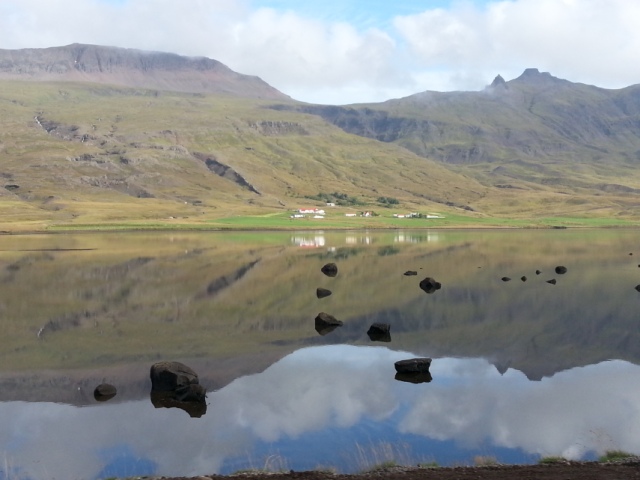
Stunning and peaceful, Iceland’s East Fjords
It is day 4 of our Iceland road trip and we left the small fishing town of Hofn behind and continued on the Ring Road (Route 1) towards the East Fjords. We knew that today was going to be specially scenic, we have driven more than 650 km from Iceland’s Capital and we started noticing that there is hardly anyone on the road. We travelled on a virtually empty road for ages before we come across another car. We are now too far for day trippers from Reykjavik and also this region is very sparsely populated and therefore road traffic here is very minimal. As our little van climbs higher and higher the drama starts unfolding, and we get more and more excited to see what is around the next hairpin bend on the road as sheer mountain side drops etched with waterfalls reveal themselves in one side of the road and the cold waters of the sea in the other.
The road is good and all tarmac, but quite narrow in places, and bridges are often one lane. Some of the mountains are dark with jagged edges and deep fissures carved by the snow melting and running down the mountain side forming pretty waterfalls; we lost count of how many waterfalls we have seen. We pass through little fishing villages that feel lost in the vast openness of the landscape, small farm houses in idyllic locations by the base of a mountain or by a lake side with views that go on for ever. There was stillness and silence and we felt like we had it all to ourselves. The air was crisp and fresh but did not feel cold, the sun was shining with the occasional cloud overhead. I wanted time to stop and that moment to go on forever, and although we drove quite a lot of miles we did not feel tired at all as the beauty of our surroundings was so calming and relaxing.
We stopped at various places to take pictures or just take in the views or walk along a small trail on a cliff top, it was an overdose of beautiful and dramatic landscapes with gorgeous Autumn colours and ice capped mountains. My pictures don’t even come close to doing justice to what we experienced on the East Fjords.
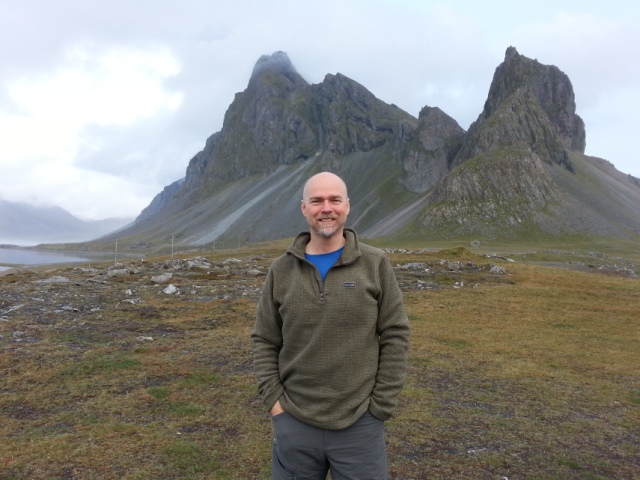
Jagged edge peaks
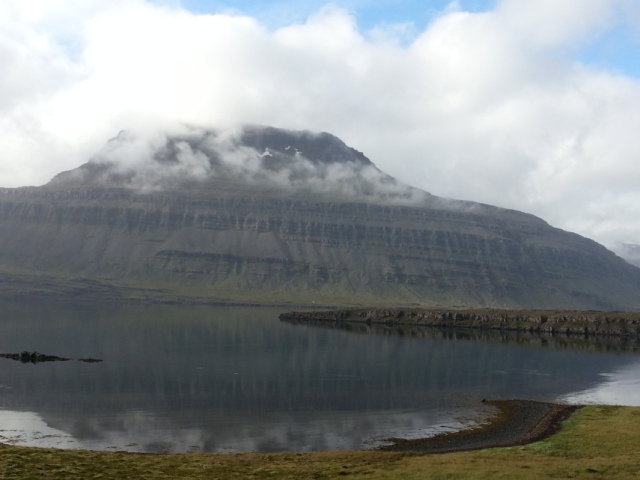
Clouds dancing around a brooding mountain peak
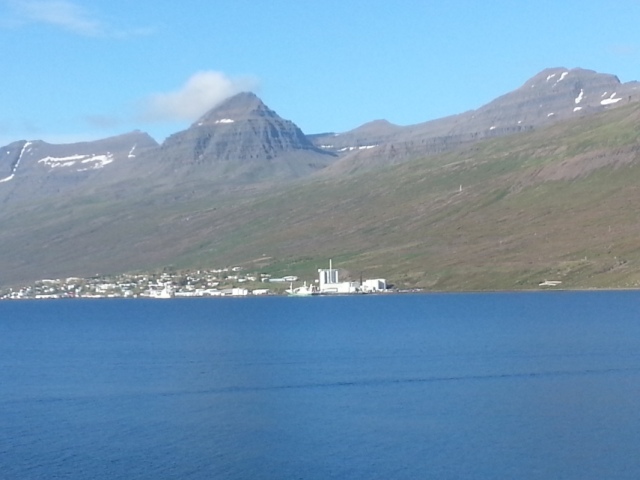
Neskaupstadur in the distance and a fish processing plant that brought prosperity to this town
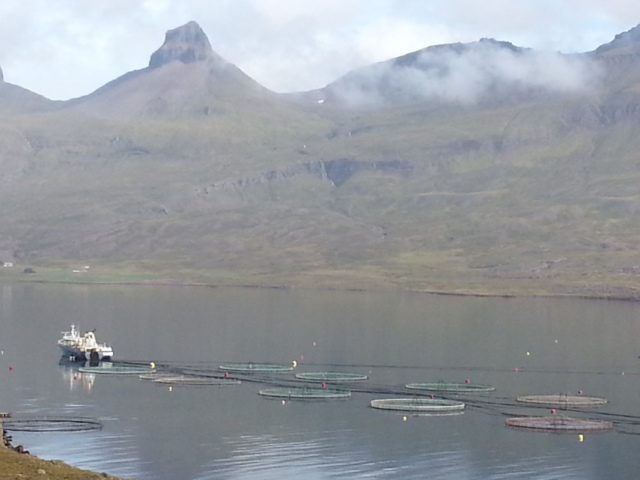
Salmon farming
We travelled through the highest highway pass in Iceland at 632 meters high, via a single lane 630 meters long tunnel to visit Neskaupstadur, a little D-tour that was so worthwhile if only for the nerve wrecking cross of the mountain pass. As we entered the tunnel we noticed the headlight of a large 4X4 coming towards us, so Brian had to quickly reverse out of the tunnel – luckily we were not too far into it and managed to get out of the way of both the 4X4 car and a police car that was driving behind it. Once at the other side of the tunnel the road drops down into the town of Neskaupstadur, which is at the end of the line. A little town that prospered during the herring boom, it has the biggest fish-processing and freezing plant in Iceland which looks out of place in this little town. After a quick look around we drove back up again for another go at the nerve wrecking tunnel.
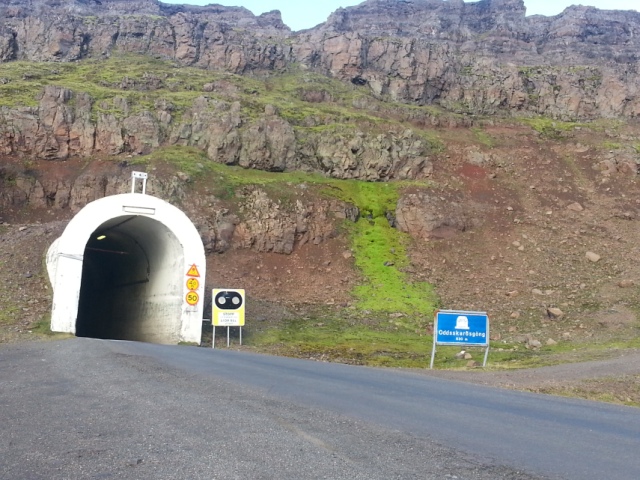
Mountain pass tunnel, 630 meters of a single lane tunnel, traffic light at the entrance was not working when we crossed
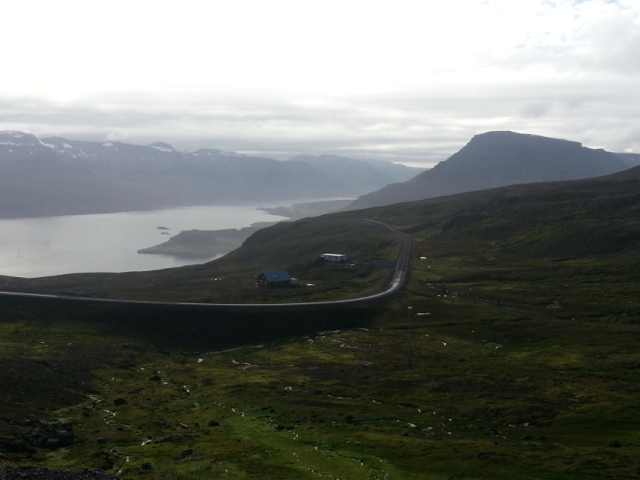
Road leading to the highest mountain pass in Iceland with stunning vistas
We finished our 4th day at a lovely lake side camp-site in Egilsstadir and although the Camp- site looked closed and there was no warden or anyone there, the toilet facilities were open and so we made ourselves comfortable by the lovely lake to watch the sunset. We noticed large swarms of midges all around the lake and my heart sank thinking our idyllic setting is now totally spoiled by these little buzzing creatures, but as soon as the sun started setting and the air got a little cooler the midges disappeared leaving us to enjoy this peaceful lake side beauty spot…bliss!
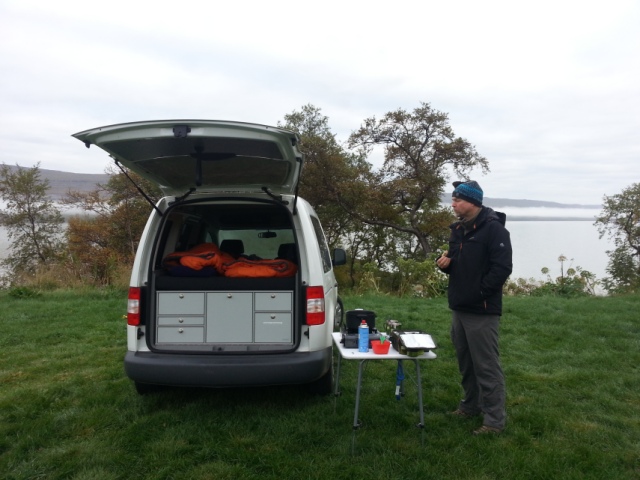
Our Camp- Site by the lake

Peaceful sunset by the lake…and no midges!
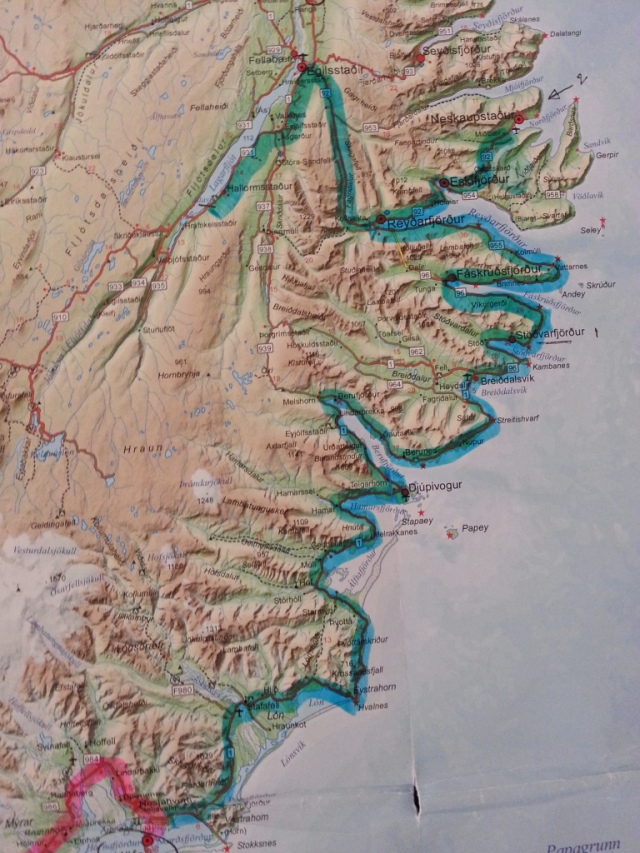
Our day 4 route, in green, through the East Fjords, including our little D-tour for the mountain pass tunnel on route 92
Day 5 sees us driving North towards Dettifoss, the largest waterfall in Iceland in terms of volume of water and reputed to be the most powerful in Europe. It is 100 meters (330 ft) wide and a drop of about 45 meters (150 ft) down into Jokulsargljufur Canyon. To access Dettifoss we came off Route 1 and joined the tarmac paved Route 862 that leads into the West side of the Waterfall. It is also possible to access it from the East side via a gravel road Route 864, but we did not visit the East side. There is a large car park and toilet facilities, and it was not particularly busy when we visited but in the summer months apparently it can get quite busy. From the car park it is about 15 minutes gentle down hill, there is well marked trails through what it looks like a post apocalypse landscape of dark lava and volcanic ash terrain in itself a very interesting and surreal experience. You can hear the thundering of the falls before you can see it and get very close and personal with this fabulous force of nature. Dettifoss falls from the Canyon’s edge into a gorge with such force that it projects a huge plume of spray up in the air and as the sun shines on it beautiful double rainbows are formed. I lost count of how many beautiful rainbows we saw as we stared down into this mighty roaring waterfall.
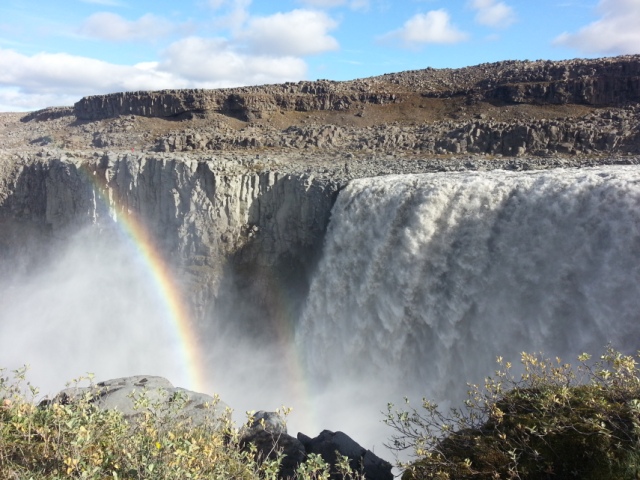
Dettifoss and a double rainbow
Back on Route 1 we are now driving towards the Myvatn Region an area of turbulent geological activity as fierce volcanic eruptions have created and transformed this area, The volcanic zone in this area lies on the boundary of the Eurasian and American Tectonic plates, as the plates move at a rate of about 2 cm every year, volcanic lava wells up between the plates and fills up the ridge . There are a group of lava craters also know as pseudo craters or rootless vents on the shores of Lake Myvatn and also form little islets on the Lake. The formation of lava lakes created by the pseudo craters eventually gave way to the formation of a forest of rock pillars the biggest of which is called Dimmuborgir. All geologic formations in this area are quite recent dating from the Ice Age and the glacial periods. It is a little nerve wrecking to think of what is going on underground as hot magma sits quietly and deadly waiting to burst out!
From Route 1 as we approached Myvatn an awful smell hit us and then we saw it, just in from of us the red/orange lunar-like landscape of Hverir with it’s belching mud flaps and boiling cauldrons, steaming vents and piping fumaroles that hiss a strange noise as steam jets out from the ground below. We parked the car already holding our noses, but totally mesmerised by the most strange and surreal of landscapes.
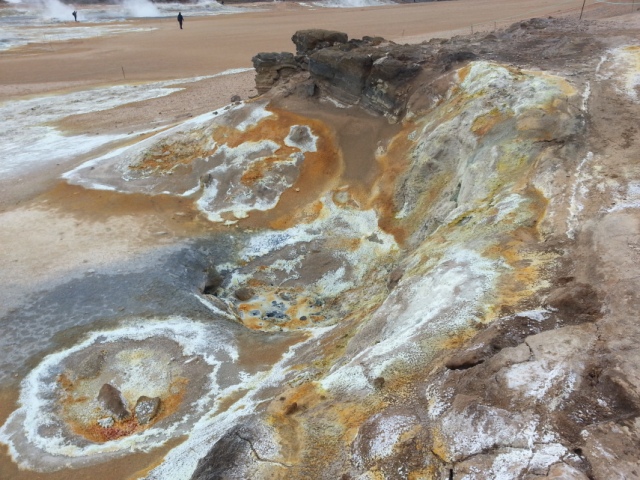
Surreal Hverir, like giant earth blisters
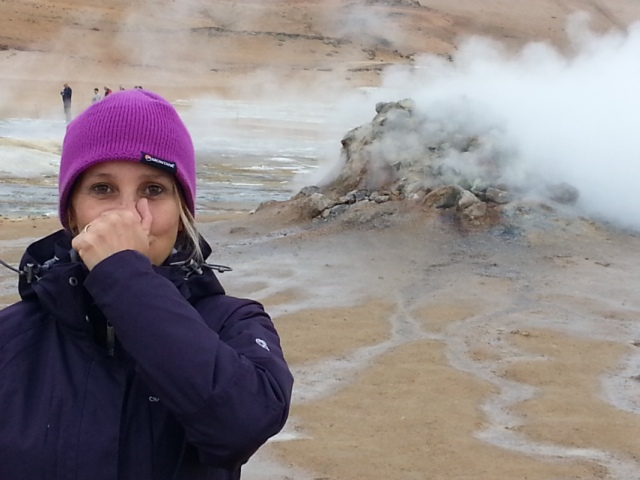
Powerful stench of sulphur, hold your nose
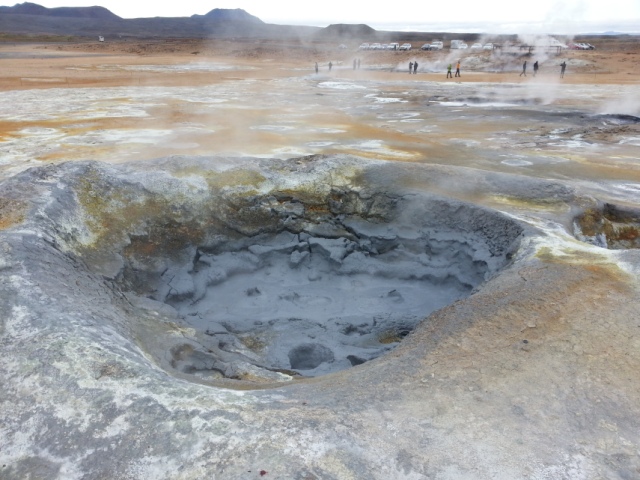
Grey and blue boiling and bubbling mud cauldrons
We found a lovely camp site with very good facilities and got ready to visit the Myvatn Nature Baths, Northern Iceland’s answer to the Blue Lagoon but a lot smaller and less busy. We loved spending a few hours soaking on the warm, milky and mineral rich water whilst taking in the panoramic views of its surrounding. Already late afternoon, the air was cool but the water was lovely and warm and we did not feel cold at all.
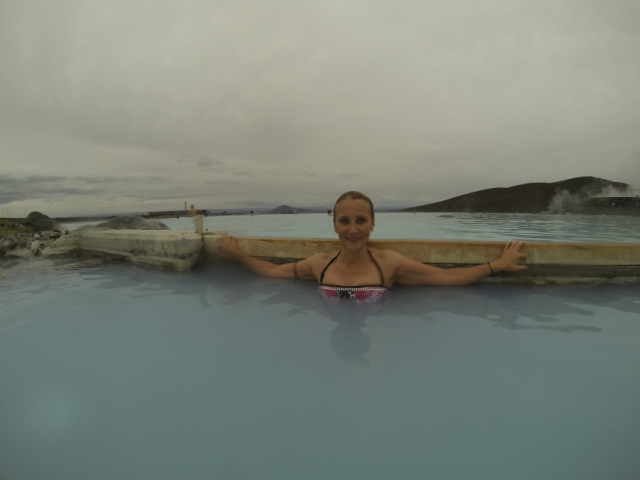
Relaxing soak at the Myvatn Nature Baths
All this relaxing in the warm waters of the Nature Baths gave us a ravenous appetite so we found a fantastic place to eat just a stone’s throw from our camp site, called Vogafjos also known as The Cow Shed. It is located at a dairy farm, surrounded by lush countryside and you can eat a meal with either views over the lush country side or of the farmers milking the cows in the shed which is fully visible from a glass window connected to the restaurant. The food is all about the local produce and it was just divine, a great way to finish off another outstanding day of exploring Iceland.
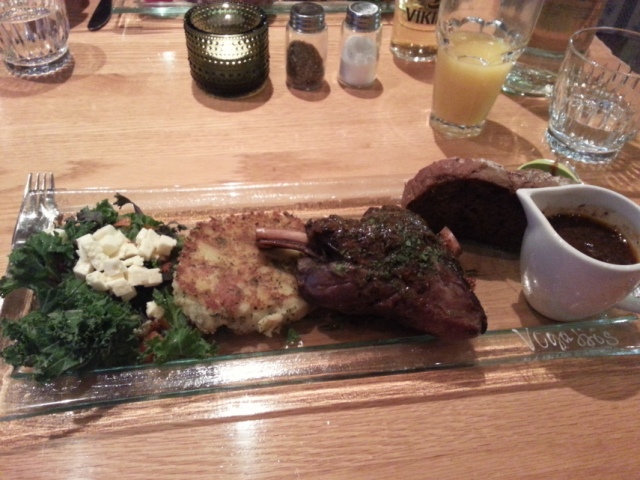
Locally sourced ingredients at Vogafjos
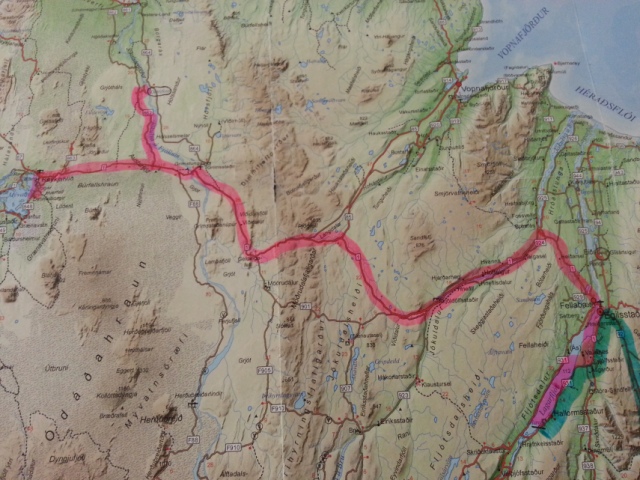
Our day 5 on Route 1 including D-tour to see Dettifoss
We wake up to beautiful sunshine and once again a Happy Camper van is parked right next to ours and like every morning we jokingly cursed them for ” stealing ” our van!! It went like this,” look, those b…ds they have our van!”….. originally that was the camper van we wanted, bigger and better designed than ours. I venture outside for a snoop into their van and get caught in a conversation with the lovely German couple Marie and Paul, who reported that originally they had booked the smaller van, but ended up with the larger one for the same price. They borrow my little lap top to transfer some photos from one full card to another with some space whilst Marie and I carry on chatting. They remind us of our children and we felt bad about all the early cursing, it is not their fault that all the Happy Campers van’s were booked out by the time we decided what van to go for. Often the people you meet on the road greatly enhance your travelling experience, and thank you Paul we enjoyed the chocolate from your home town.
After breakfast in the great kitchen facilities of our camp site we spent some more time in the Myvatn area and visited Dimmiborgir which means “dark castles” named after the giant jagged lava formations and we walked some of the trails among these solidified lava creations, the Autumn colours against the black volcanic rock made it all even more stunning.
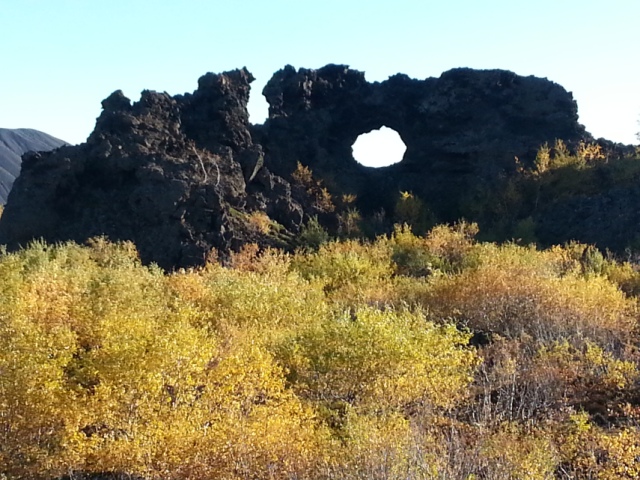
Solid lava formations among the beautiful Autumnal vegetation
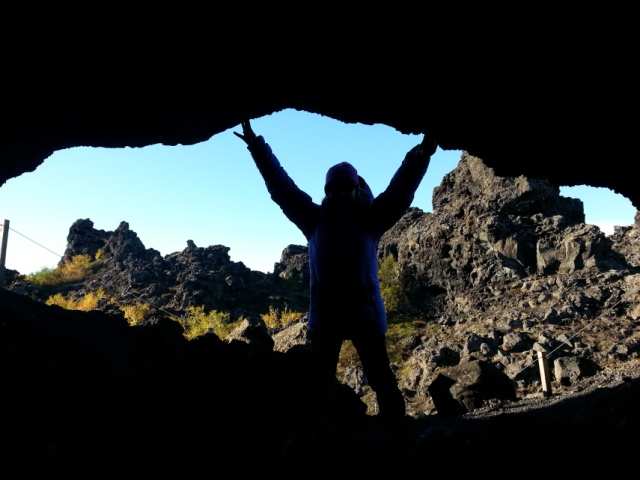
Dimmuborgir, from inside one of the many lava caves
We also stopped briefly at Grjotagia, a gaping fissure and cave filled with very hot water. We visited it in the morning with the sun filtering through, bathing in the cave’s hot water is not possible since the temperature of the water is about 45 degrees C and far too hot for bathing.
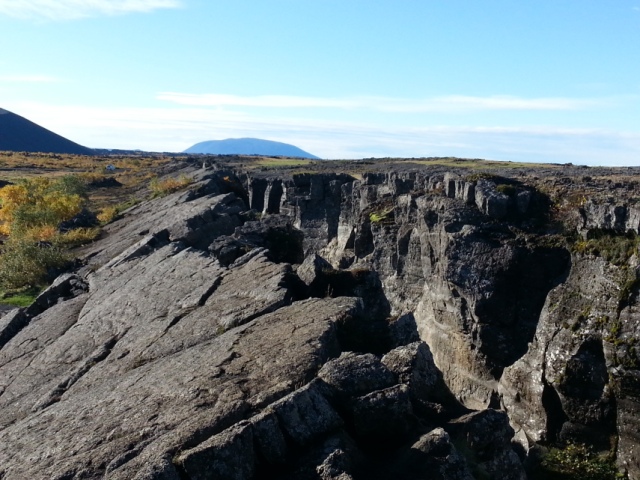
Massive earth fissure just above the cave
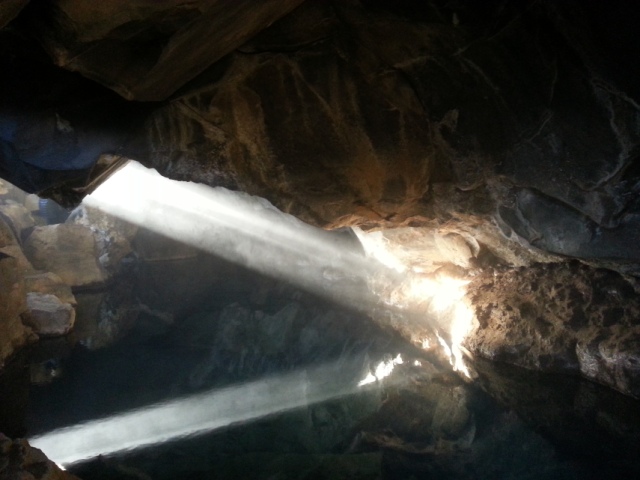
Grjotagia cave with the sun streaming in , Game of Thrones fans might recognise this place
We then got back on the road and travelled North to the fishing town of Husavik, where we wanted to do a whale watching tour. So we arrived there near lunch time and booked ourselves into the Gentle Giants tour that was due to depart at 1:30 pm from the Harbour. We boarded the boat and got all kitted out for the tour. Unfortunately we did not see the whales, although we did see some playful Harbour Porpoises and loved the beautiful scenery of snow capped peaks and small water falls coming down the mountains and falling into the sea. It was also lovely to see Husavik from the water as we approached on the way back. Because we did not spot any whales we were offered another tour for free that we could have taken early next morning, but unfortunately we did not have enough time to take them up on their generous and very fair offer.
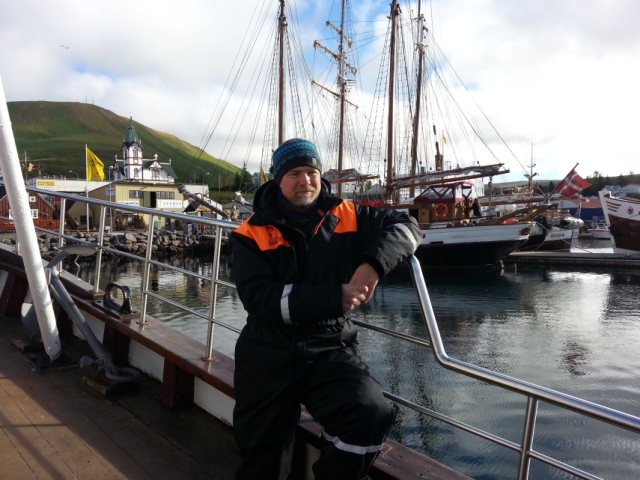
Whale tour…but no Whales. Brian looking very fat in his flotation suit was the next best thing hahaha!
We stayed overnight at a camp site near the harbour and had dinner at this charming and homely wood chalet style fish restaurant (see picture below) right by the harbour. The sea food was delicious and so fresh as we chose to eat the catch of the day. And like everywhere else we visited in this wonderful country, the staff were very friendly and welcoming.
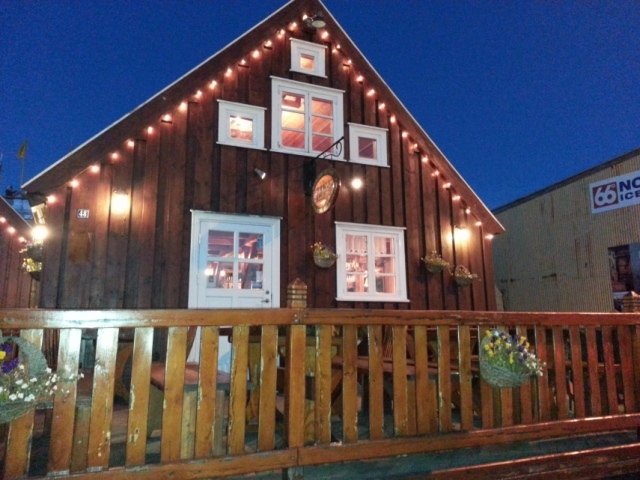
Dinner was at this cute wood chalet restaurant by the harbour
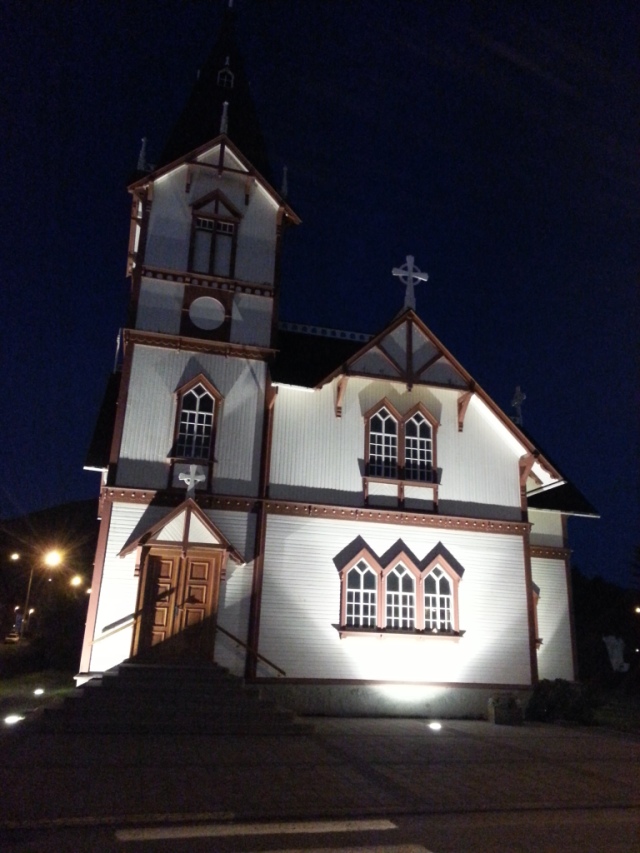
Husavik’s main church all lit up at night, it looks like it is leaning but it is just my poor photographic skills.
On our day 5 we did the shortest drive and it was nice to slow the pace a little, see below in green our route to Husavik.
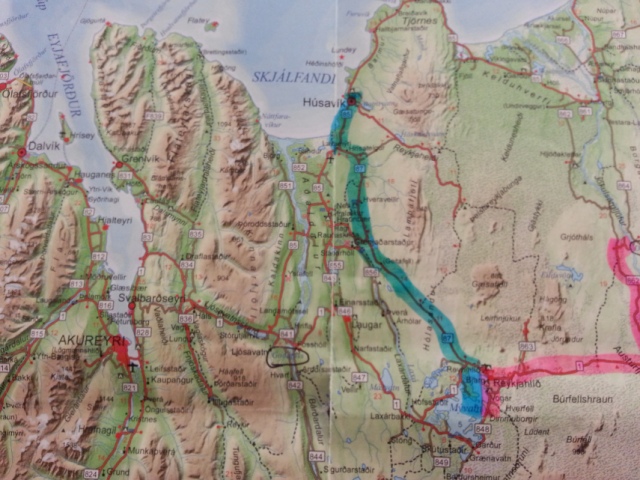
Day 5 just a short drive to Husavik
Day 6 and our longest drive, with our first stop at yet another beautiful waterfall. This time Godafoss “Waterfall of the Gods”.
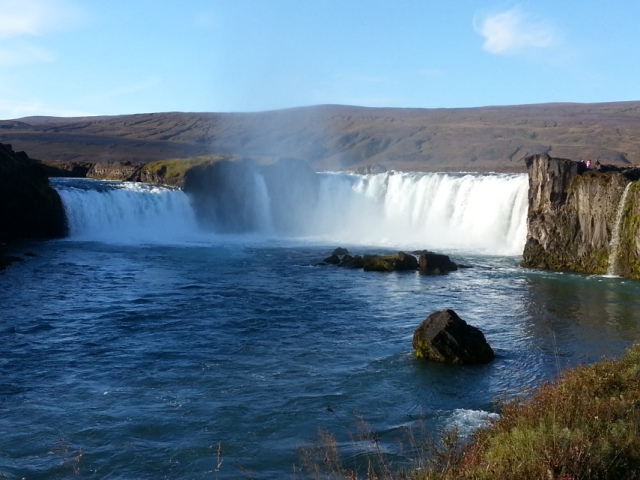
Godafoss, might not be the most powerful, but it is a beauty
Akureyri
Next we arrived at Akureyri, Iceland’s second largest city and Capital of North Iceland. Although only about 18,000 people live here, it is compact and charming, sitting prettily by the snow capped peaks and not far from the Arctic Circle. The air is fresh, the centre was lively with nice café’s and restaurants and so we decided to have our lunch at the “Akureyri Backpackers Hostel” in the heart of the town with its cool travellers vibe and fantastic coffee and snack meals. I noticed that at every place we have eaten on display they will have jugs of water and glasses, so you can just help yourself to a drink of water; I found it to be such a great custom in particular because the water is Iceland is the best I have ever tasted anywhere.
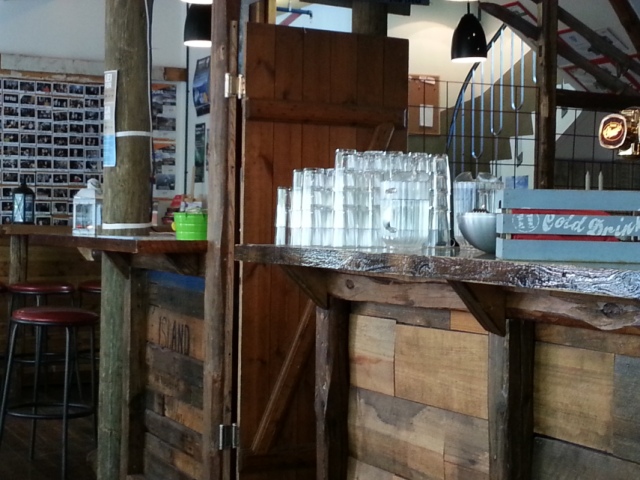
I loved how jugs of water and glasses are on display everywhere…just help yourself
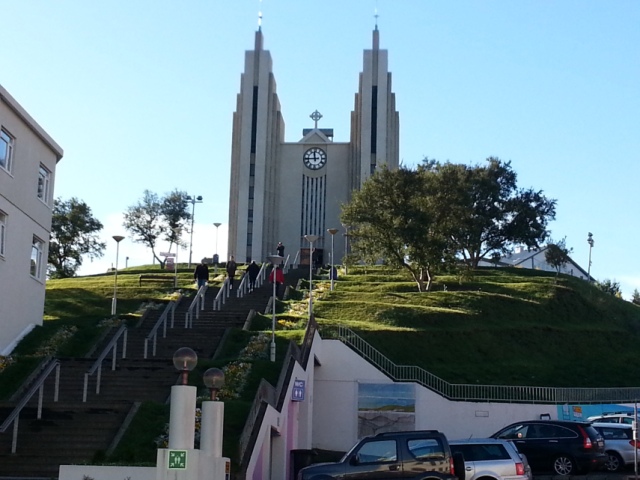
Akureyri ‘s landmark church
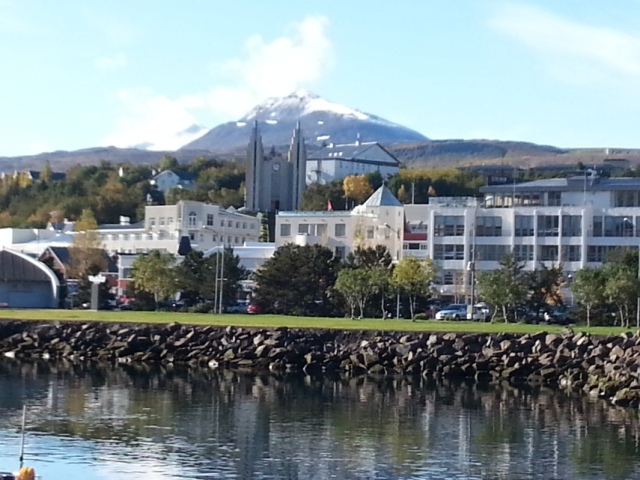
Akureyri, Capital of North Iceland is nestled among snow capped peaks
With our bellies full we carried on all the way down to the Snaefellsnes Peninsula, with lots more stops at scenic and interesting places.
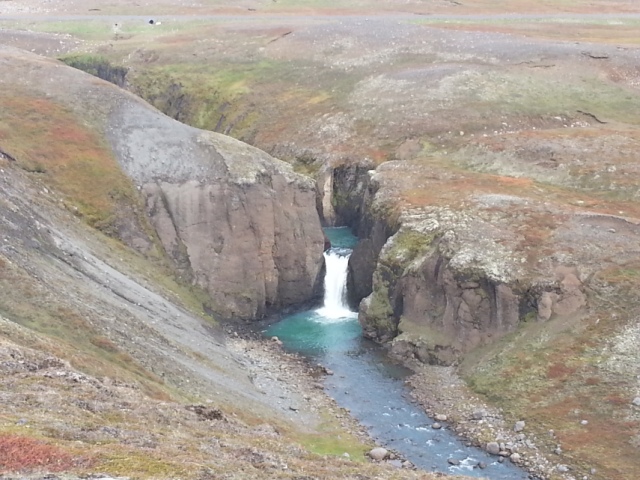
Emerald green water nestled in a landscape of red, green, yellow moss
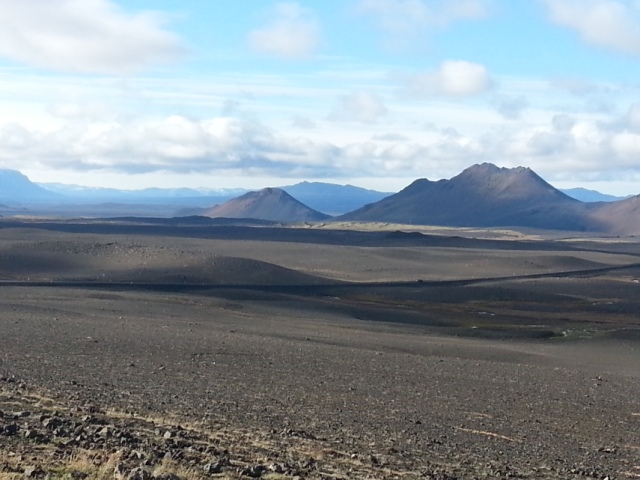
Moon like landscapes
We arrived early evening at Borganes which is at the start of the Peninsula and started searching for a place to stay overnight. It took us some time to find an open camp site, and in fact we ended up staying in a camp site that was actually closed so the toilet facilities were locked up. We were able to use an outside sink and running water to cook our miserable dinner of pot noodles, since we were so tired and had no energy to go looking for a restaurant to eat. That was our last night in our little camper van; our love-hate relationship with our van reached our limits of how much we were prepared to “rough it” so to speak. so we decided that the next day after exploring the beautiful Snaefellsnes Peninsula we would head towards the bright lights of Iceland’s Capital and the comforts of the lovely Hotel Hilda, nicely located in the centre of the action and within walking distance of all the attractions we wanted to see in Reykjavik.
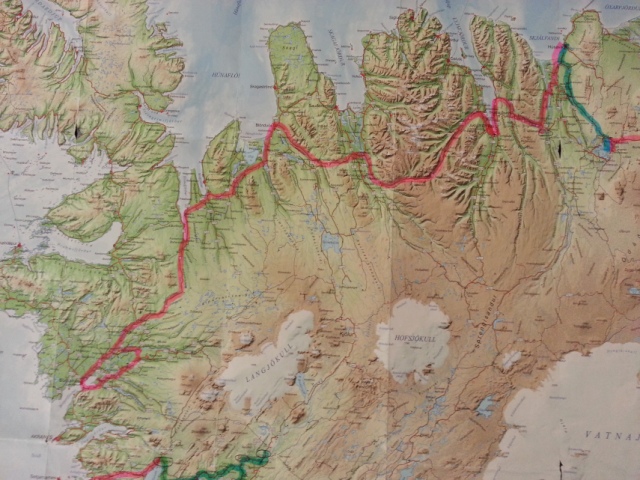
Route of our day 6 (in pink) and our longest drive. (With a big detour at the end trying unsuccessfully to find a camp-site still open this late in the year.)
Originally our plan was not to spend any time in the Capital, but I am so glad we changed our plans after my meltdown in the camper van and Brian had to take control of the situation and make the executive decision of booking us into a lovely hotel in Reykjavik. I don’t think you appreciate the comforts of a soft warm bed and a “en suite” until you don’t have it. There is only so much adventure a girl can handle and although I don’t regret for one second our camper van road trip, it was time to get back into my comfort zone. Enough of pot noodles and middle-of-the-night walks to the camp-site toilets! We would have a camper van again to explore Iceland in a heartbeat, but maybe in the future we would choose a bigger van instead.
Day 7 we managed to drive all round the beautiful Snaefellsnes Peninsula situated in Western Iceland and again an area of incredible geological activity including the Snaefellsjokull Volcano, regarded as one of the symbols of Iceland. It has a glacier at its peak and apparently it was the setting for the novel ” Journey to the Center of Earth” by Jules Verne. The area around it has been designated a National Park .
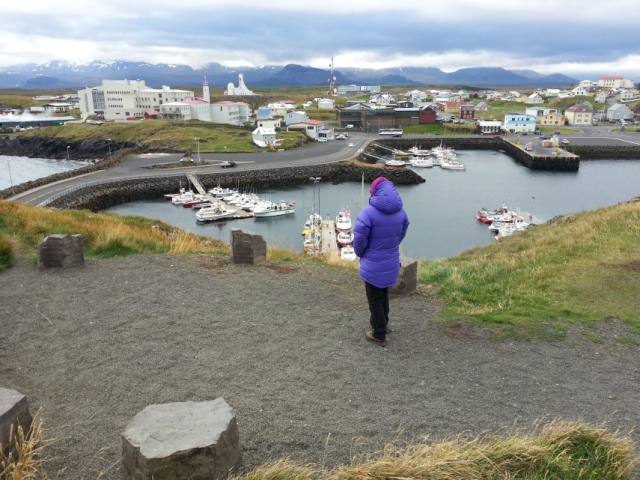
Pretty fishing villages dotted around the Snaefellsnes Peninsula, here is the view over Stykkisholmur from the lighthouse hill. A ferry called Baldur goes from here over to the West fjords, something we did consider doing, but lacked time.
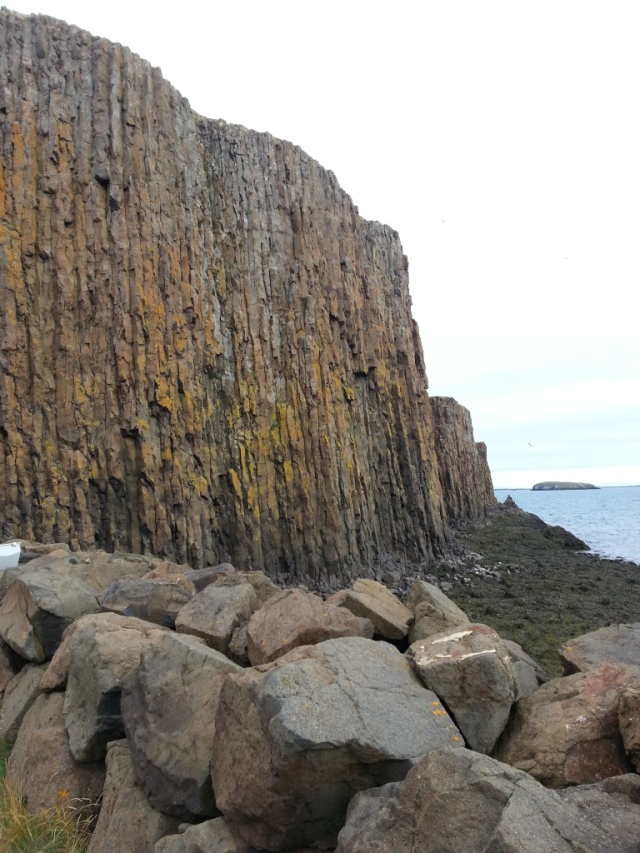
Amazing geology
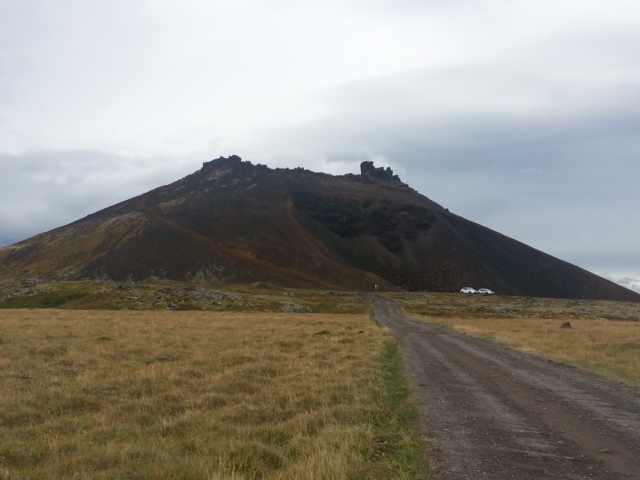
Perfect cone crater which we stopped at and walked up
Later in the afternoon we headed towards the bright lights of Iceland’s Capital and the comforts of the lovely Hotel Hilda. See below in green our route on day 7.
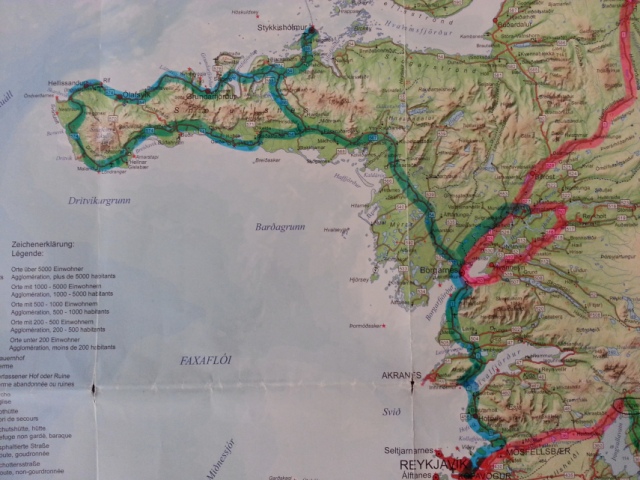
Our day 7 route around the Snaelfeness Peninsula and ending up in Reykjavik by the evening, we passed through an incredibly long underwater tunnel to reach Iceland’s Capital.
Reykjavik
With a great night’s sleep and renewed energy we spent our last full day in Iceland exploring this charming place, the world’s Northernmost capital of a sovereign state with a population of around 120,000 people. It is know as one of the cleanest and safest cities in the world and we can certainly vouch for that. We wanted to visit The National Museum of Iceland to learn more about its settlement history and cultural heritage and I also wanted to get a birds eye view of the city from the tower of the Lutheran Church Hallgrimskirkja. We walked around old and new Reykjavik, looking at modern buildings like the glistening Harpa, but also enjoyed the more traditional buildings, colourful and quirky architecture and houses made of corrugated iron. We also loved the old harbour area and exploring at night when the city light’s up and all the cool bars, restaurants and café’s come to life.
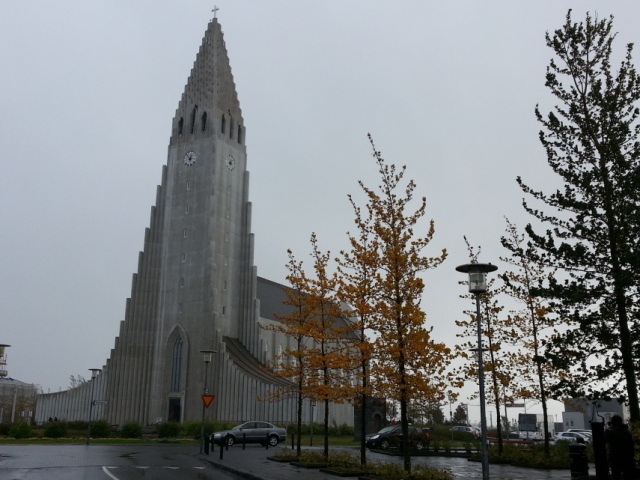
Hallgrimskirkja takes centre stage in the Capital City
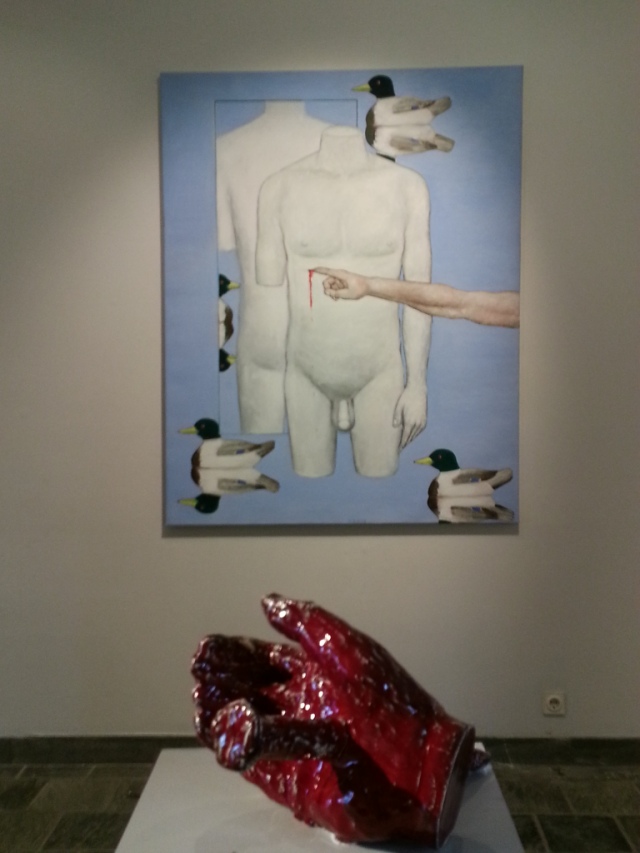
Inside the Lutheran church is quite plain with some peculiar art and an amazing organ (and I’m not talking about the art work)
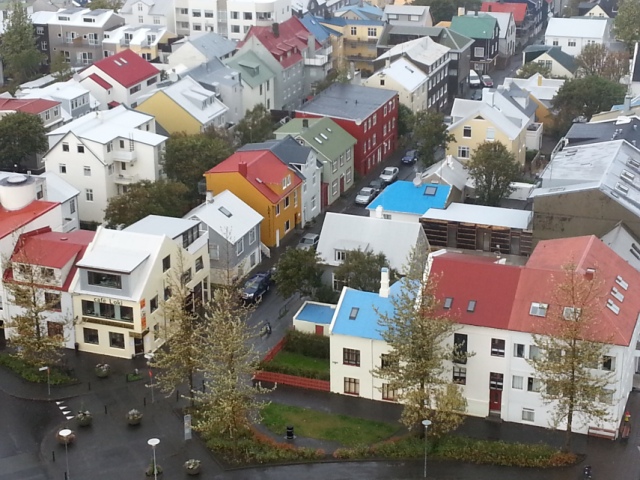
View from the church tower, the houses looking like they are made of Lego. I loved how colourful they are.
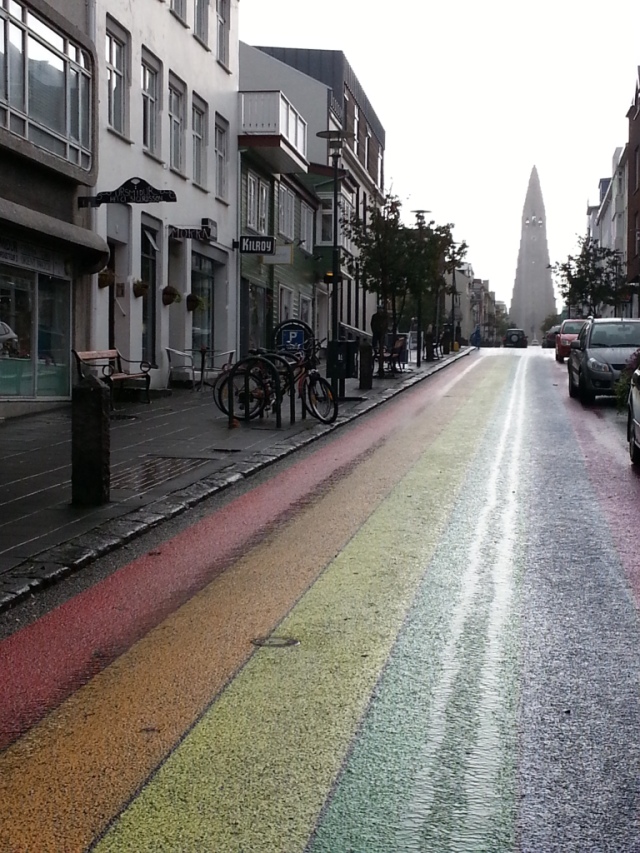
Rainbow roads in a VERY clean capital city.
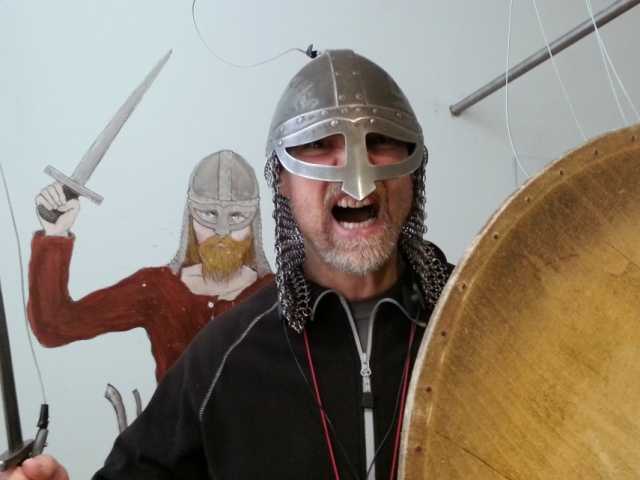
Playing Vikings at the National Museum of Iceland and learning all about its turbulent history
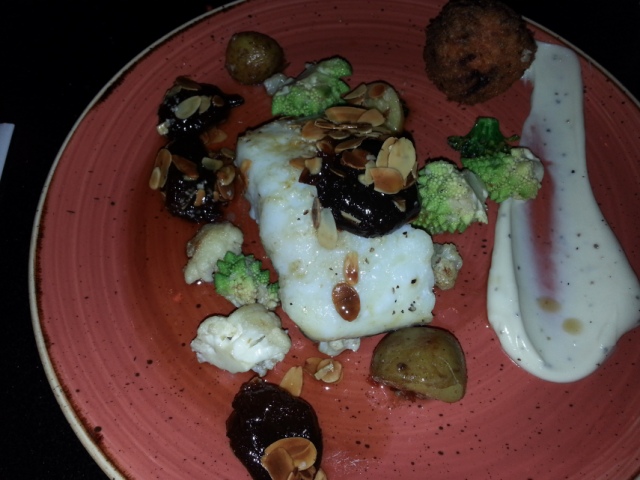
Fabulous food
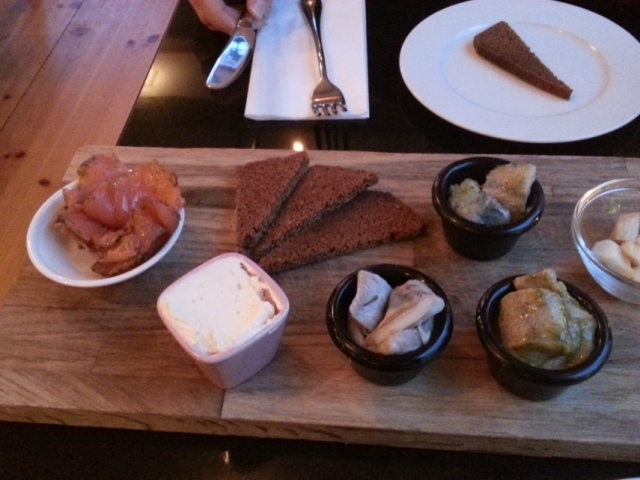
Yummy sea food platter called “traditional Iceland” at the Geysir Bistro in Reykjavik (jury still out on the fermented shark though!)
We also recommend the very humble harbour restaurant called Sagreiffin or Seabaron, serving totally delicious lobster soup and you can also choose from a fridge full of fresh fish skewers that can be grilled for you and brought to your very humble and often shared table. This place has a very laid back and authentic vibe. The prices are also very friendly to your pocket, we ate here on a recommendation from the friendly receptionist at our hotel on our first night in the Iceland Capital. It is a gem of a place.
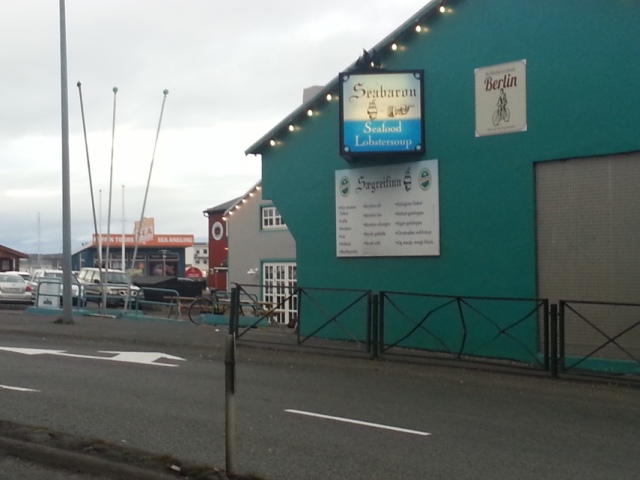
The lobster soup served here is a must
Day 9 and after a wholesome breakfast at our hotel we packed our bags back into our camper van and headed for the Blue Lagoon. I did not want to leave Iceland without a soak in the warm waters of this geothermal pool set amid an incredible black lava field. The water is a balmy 38 degrees C and it is mineral rich with some blue-green algae and the added benefit of smooth silica mud which is supposed to be very good for your skin. I recommend that you watch the short promotional film made by the company that run this very commercialized place in order to know what to do and expect. But basically at check in you are given a bracelet that lets you get through the gates, open you locker at the large and well organized changing rooms and you can also use it to pay for drinks etc.. at the pool bar. You have to shower before entering the pool in the open showers or in the private shower cubicles, preferably in the nude. I took my own towel, but I did hire a robe to keep me warm on the way in and on the way out of the pool, I also took my Havaiana flip flops and left them by the side of the pool until ready to come out. There are places to hang the robe by the pool, but I just left it on top of a chair and no one touched it. We loved the experience. We got hold of some silica which you can get from various boxes placed around the pool and I covered my face and Brian’s with it for few minutes before rinsing it off. My skin did feel nice and soft afterwards. Do remember to put LOTS of conditioner into your hair since the minerals in the pool water are not very kind to your hair. Conditioner and shampoo are included in you ticket price and there are big tubs of both in the changing rooms. The Pool area is quite big and we explored it well; there is a steam room, a funky cave and a waterfall which you can stand under to massage your back. We loved the whole experience and although it is a little pricey I did think it was well worth it. We also had our lunch at the Blue Lagoon Restaurant since we were very hungry and did not want to wait until we got to the Airport.
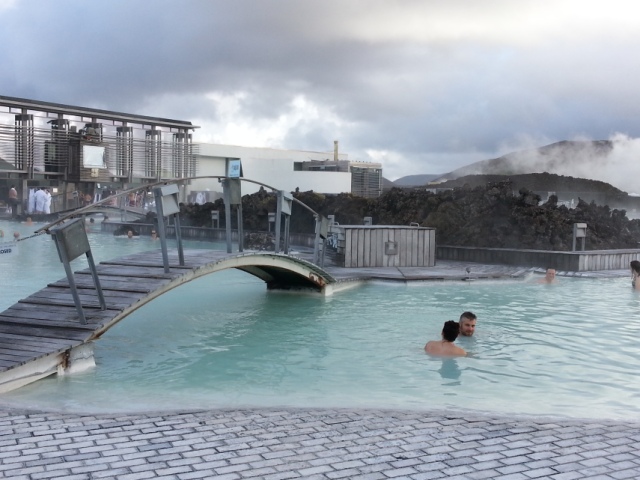
Blue Lagoon, set among a volcanic lava field
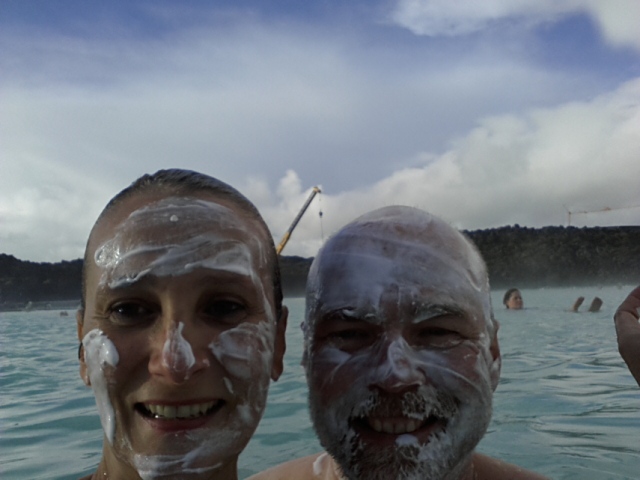
Silica masks for baby soft skin
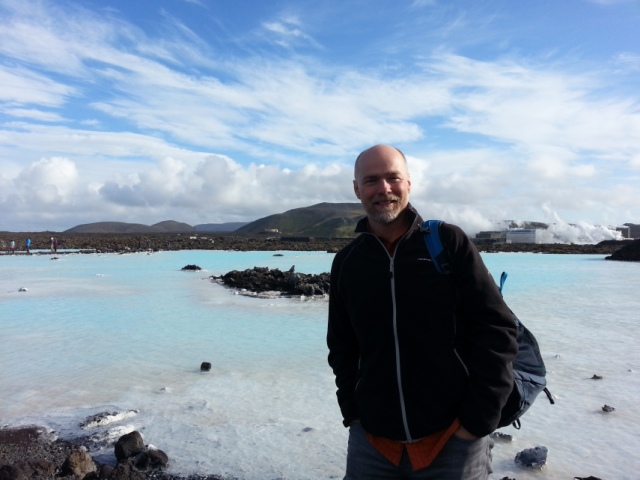
Finishing off our adventure at the Blue Lagoon, see the Geothermal Power Plant at the back
After our lovely and relaxing soak in the Blue Lagoon and our meal at the Blue Lagoon restaurant we got back on our camper van and drove the short distance to the large Warehouse where we had picked up our camper van 9 days earlier, located very near the Airport.
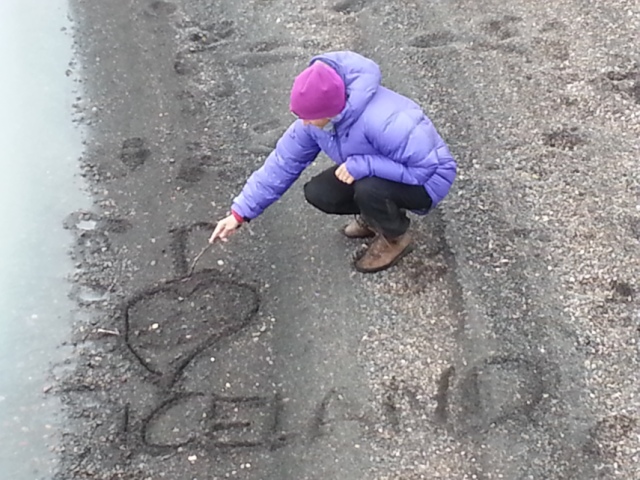
Hope we will be back again one day
Sadly it was the end of our road trip in Iceland and what an incredible adventure we had. It is an extraordinary country that has totally surprised and captivated us. I loved Iceland’s stunning and varied landscapes, raw nature, warm and friendly people, and I left feeling that there is so much more I want to experience that another trip to Iceland in the future is a must, perhaps next time in the winter.
Once again apologies for the incorrect spelling of the Icelandic words and names of places also apologies that my pictures don’t do justice to this stunning Country. My next post will be on how much this road trip cost us and some essential information and tips.
